publications
I have had the opportunity to contribute to 35 publications, including 12 first-author research articles, 4 first-author review articles, 17 co-authored publications, and 3 senior-authored publications
2023
-
 Genetic associations with age at dementia onset in the PSEN1 E280A Colombian kindredJesse Nicholas Cochran, Juliana Acosta‐Uribe, Bianca T. Esposito, and 27 more authorsAlzheimer’s & Dementia, 2023
Genetic associations with age at dementia onset in the PSEN1 E280A Colombian kindredJesse Nicholas Cochran, Juliana Acosta‐Uribe, Bianca T. Esposito, and 27 more authorsAlzheimer’s & Dementia, 2023Genetic associations with Alzheimer’s disease (AD) age at onset (AAO) could reveal genetic variants with therapeutic applications. We present a large Colombian kindred with autosomal dominant AD (ADAD) as a unique opportunity to discover AAO genetic associations. A genetic association study was conducted to examine ADAD AAO in 340 individuals with the PSEN1 E280A mutation via TOPMed array imputation. Replication was assessed in two ADAD cohorts, one sporadic early‐onset AD study and four late‐onset AD studies. 13 variants had p<1×10−7 or p<1×10−5 with replication including three independent loci with candidate associations with clusterin including near CLU. Other suggestive associations were identified in or near HS3ST1, HSPG2, ACE, LRP1B, TSPAN10, and TSPAN14. Variants with suggestive associations with AAO were associated with biological processes including clusterin, heparin sulfate, and amyloid processing. The detection of these effects in the presence of a strong mutation for ADAD reinforces their potentially impactful role.
-
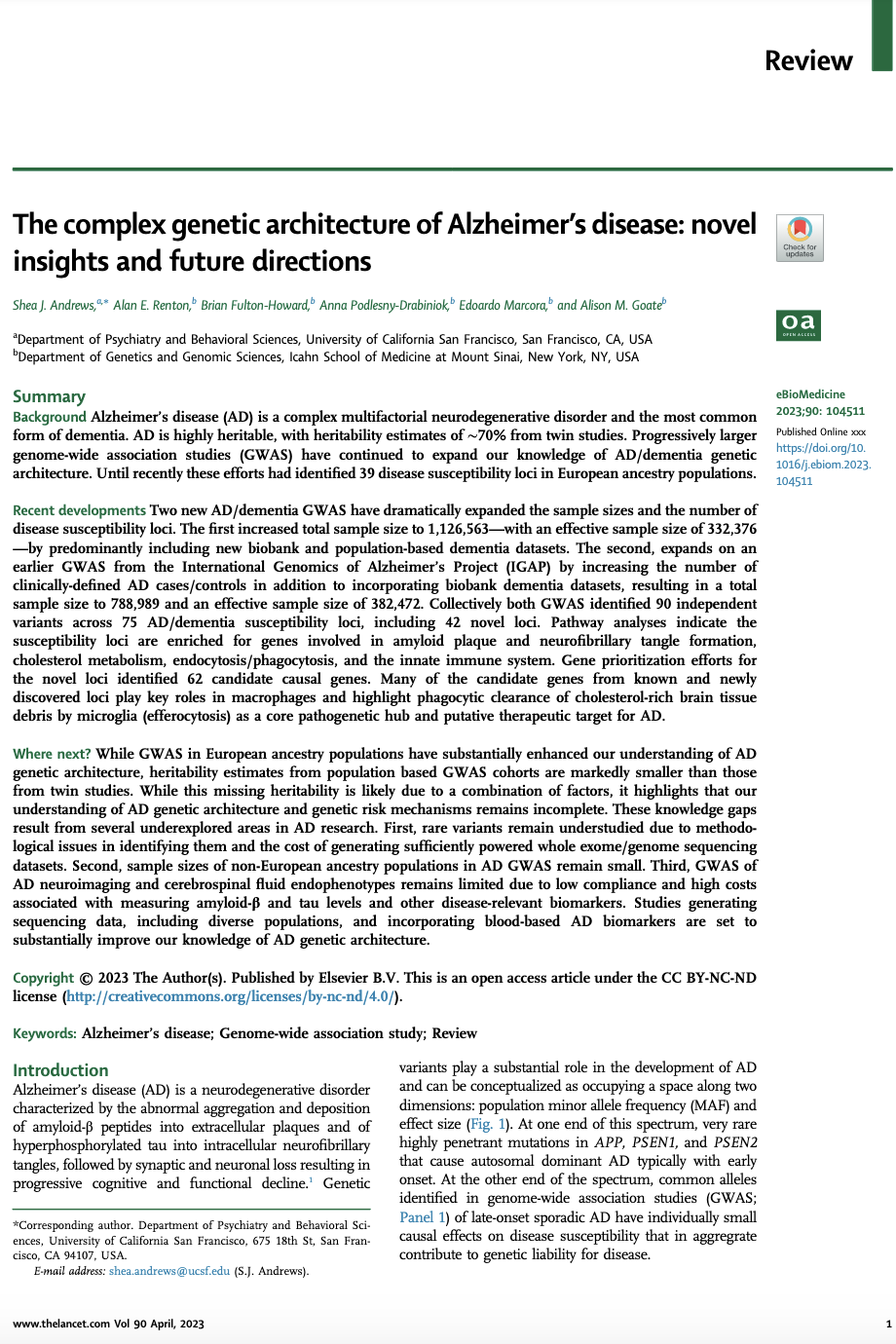 The complex genetic architecture of Alzheimer’s disease: novel insights and future directionsShea J. Andrews, Alan E. Renton, Brian Fulton-Howard, and 3 more authorseBioMedicine, 2023
The complex genetic architecture of Alzheimer’s disease: novel insights and future directionsShea J. Andrews, Alan E. Renton, Brian Fulton-Howard, and 3 more authorseBioMedicine, 2023Background Alzheimer’s disease (AD) is a complex multifactorial neurodegenerative disorder and the most common form of dementia. AD is highly heritable, with heritability estimates of ∼70% from twin studies. Progressively larger genome-wide association studies (GWAS) have continued to expand our knowledge of AD/dementia genetic architecture. Until recently these efforts had identified 39 disease susceptibility loci in European ancestry populations. Recent developments Two new AD/dementia GWAS have dramatically expanded the sample sizes and the number of disease susceptibility loci. The first increased total sample size to 1,126,563—with an effective sample size of 332,376—by predominantly including new biobank and population-based dementia datasets. The second, expands on an earlier GWAS from the International Genomics of Alzheimer’s Project (IGAP) by increasing the number of clinically-defined AD cases/controls in addition to incorporating biobank dementia datasets, resulting in a total sample size to 788,989 and an effective sample size of 382,472. Collectively both GWAS identified 90 independent variants across 75 AD/dementia susceptibility loci, including 42 novel loci. Pathway analyses indicate the susceptibility loci are enriched for genes involved in amyloid plaque and neurofibrillary tangle formation, cholesterol metabolism, endocytosis/phagocytosis, and the innate immune system. Gene prioritization efforts for the novel loci identified 62 candidate causal genes. Many of the candidate genes from known and newly discovered loci play key roles in macrophages and highlight phagocytic clearance of cholesterol-rich brain tissue debris by microglia (efferocytosis) as a core pathogenetic hub and putative therapeutic target for AD. Where next? While GWAS in European ancestry populations have substantially enhanced our understanding of AD genetic architecture, heritability estimates from population based GWAS cohorts are markedly smaller than those from twin studies. While this missing heritability is likely due to a combination of factors, it highlights that our understanding of AD genetic architecture and genetic risk mechanisms remains incomplete. These knowledge gaps result from several underexplored areas in AD research. First, rare variants remain understudied due to methodological issues in identifying them and the cost of generating sufficiently powered whole exome/genome sequencing datasets. Second, sample sizes of non-European ancestry populations in AD GWAS remain small. Third, GWAS of AD neuroimaging and cerebrospinal fluid endophenotypes remains limited due to low compliance and high costs associated with measuring amyloid-β and tau levels and other disease-relevant biomarkers. Studies generating sequencing data, including diverse populations, and incorporating blood-based AD biomarkers are set to substantially improve our knowledge of AD genetic architecture.
2022
-
 The role of mitochondrial genome abundance in Alzheimer’s diseaseNadia V. Harerimana, Devashi Paliwali, Carmen Romero‐Molina, and 5 more authorsAlzheimer’s & Dementia, 2022
The role of mitochondrial genome abundance in Alzheimer’s diseaseNadia V. Harerimana, Devashi Paliwali, Carmen Romero‐Molina, and 5 more authorsAlzheimer’s & Dementia, 2022Mitochondrial dysfunction is an early and prominent feature of Alzheimer’s disease (AD), with impaired energy metabolism preceding the onset of clinical symptoms. Here we propose an update to the mitochondrial dysfunction hypothesis of AD based on recent results examining the role of mitochondrial genome abundance in AD. In a large post mortem study, we show that lower brain mitochondrial genome abundance is associated with a greater odds of AD neuropathological change and worse cognitive performance. We hypothesize that lower mitochondrial genome abundance impairs mitochondrial function by reducing mitochondrial bioenergetics, thereby impacting neuronal and glial cell function. However, it remains to be determined if mitochondrial dysfunction causes, mediates, or is a by‐product of AD pathogenesis. Additional support for this hypothesis will be generated by linking peripheral blood mitochondrial genome abundance to AD and establishing clinical trials of compounds that upregulate total mitochondrial genome abundance or boost mitochondrial mass.
-
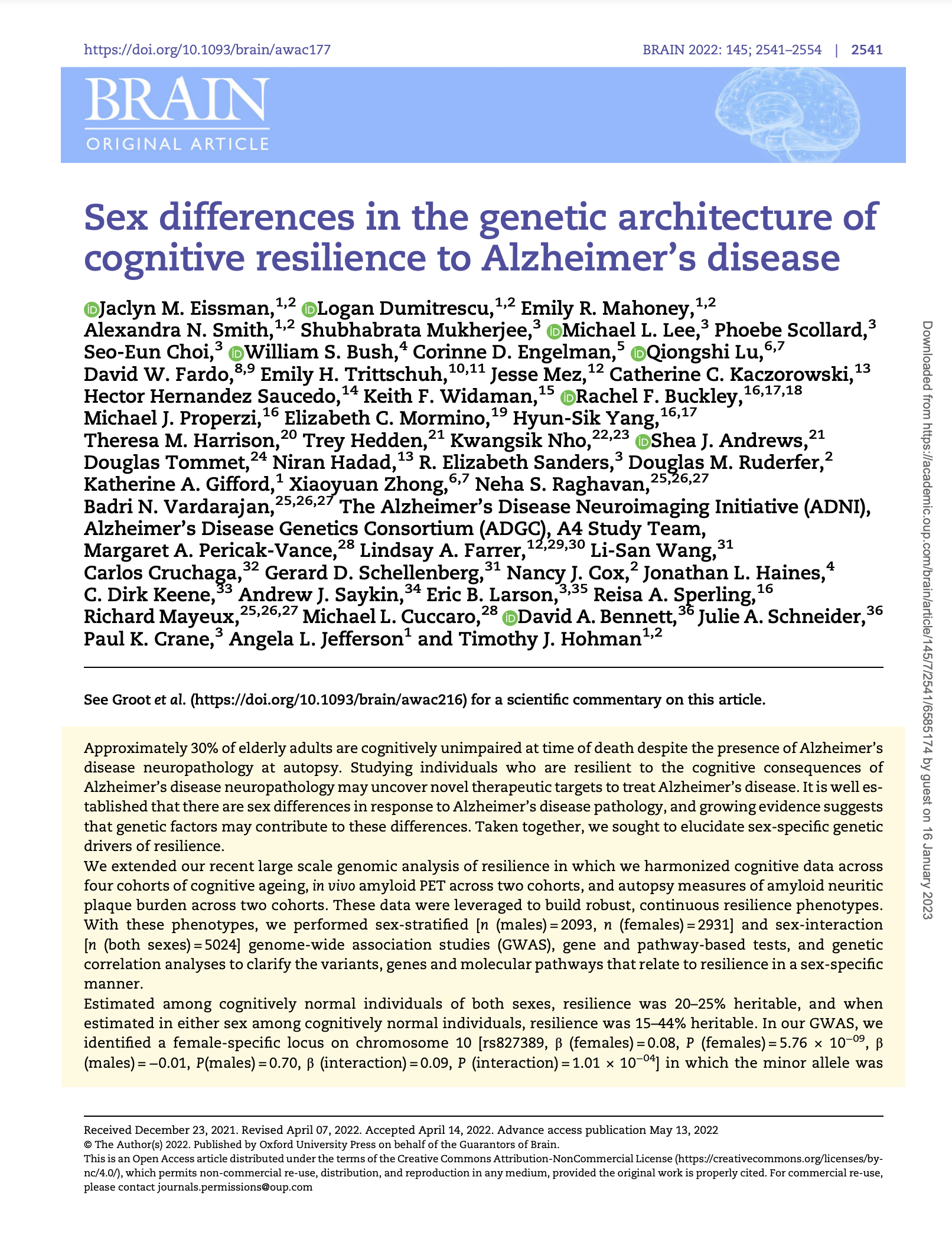 Sex differences in the genetic architecture of cognitive resilience to Alzheimer’s diseaseJaclyn M. Eissman, Logan Dumitrescu, Emily R. Mahoney, and 51 more authorsBrain, 2022
Sex differences in the genetic architecture of cognitive resilience to Alzheimer’s diseaseJaclyn M. Eissman, Logan Dumitrescu, Emily R. Mahoney, and 51 more authorsBrain, 2022Approximately 30% of elderly adults are cognitively unimpaired at time of death despite presence of Alzheimer’s disease (AD) neuropathology at autopsy. Studying individuals who are resilient to the cognitive consequences of AD neuropathology may uncover novel therapeutic targets to treat AD. It is well-established that there are sex differences in response to AD pathology, and growing evidence suggests that genetic factors may contribute to these differences. Taken together, we sought to elucidate sex-specific genetic drivers of resilience. We extended our recent large-scale genomic analysis of resilience in which we harmonized cognitive data across four cohorts of cognitive aging, in-vivo amyloid PET across two cohorts, and autopsy measures of amyloid neuritic plaque burden across two cohorts. These data were leveraged to build robust, continuous resilience phenotypes. With these phenotypes, we performed sex-stratified (N(males) = 2,093, N(females) = 2,931) and sex-interaction (N(both sexes) = 5,024) genome-wide association studies (GWAS), gene- and pathway-based tests, and genetic correlation analyses to clarify the variants, genes, and molecular pathways that relate to resilience in a sex-specific manner. Estimated among cognitively normal individuals of both sexes, resilience was 20-25% heritable, and when estimated in either sex among cognitively normal individuals, resilience was 15-44% heritable. In our GWAS, we identified a female-specific locus on chromosome 10 (rs827389, β(females) = 0.08, P(females) = 5.76E-09, β(males)=-0.01, P(males) = 0.70, β(interaction) = 0.09, P(interaction) = 1.01E-04) in which the minor allele was associated with higher resilience scores among females. This locus is located within chromatin loops that interact with promoters of genes involved in RNA processing, including GATA3. Finally, our genetic correlation analyses revealed shared genetic architecture between resilience phenotypes and other complex traits, including a female-specific association with frontotemporal dementia and male-specific associations with heart rate variability traits. We also observed opposing associations between sexes for multiple sclerosis, such that more resilient females had a lower genetic susceptibility to multiple sclerosis, and more resilient males had a higher genetic susceptibility to multiple sclerosis. Overall, we identified sex differences in the genetic architecture of resilience, identified a female-specific resilience locus, and highlighted numerous sex-specific molecular pathways that may underly resilience to AD pathology. This study illustrates the need to conduct sex-aware genomic analyses to identify novel targets that are unidentified in sex-agnostic models. Our findings support the theory that the most successful treatment for an individual with AD may be personalized based on their biological sex and genetic context.
-
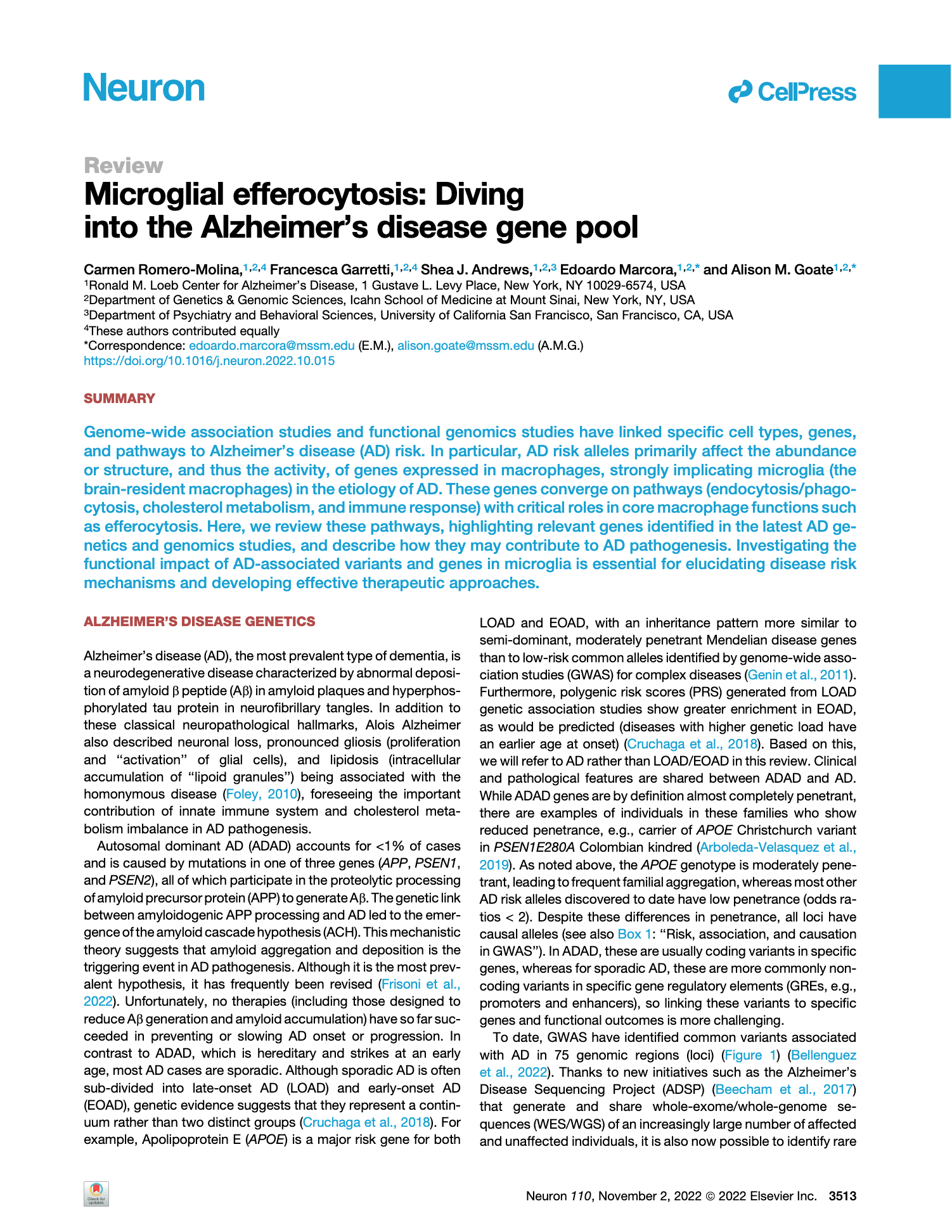 Microglial efferocytosis: Diving into the Alzheimer’s disease gene poolCarmen Romero-Molina, Francesca Garretti, Shea J. Andrews, and 2 more authorsNeuron, 2022
Microglial efferocytosis: Diving into the Alzheimer’s disease gene poolCarmen Romero-Molina, Francesca Garretti, Shea J. Andrews, and 2 more authorsNeuron, 2022Genome-wide association studies and functional genomics studies have linked specific cell types, genes, and pathways to Alzheimer’s disease (AD) risk. In particular, AD risk alleles primarily affect the abundance or structure, and thus the activity, of genes expressed in macrophages, strongly implicating microglia (the brain-resident macrophages) in the etiology of AD. These genes converge on pathways (endocytosis/phagocytosis, cholesterol metabolism, and immune response) with critical roles in core macrophage functions such as efferocytosis. Here, we review these pathways, highlighting relevant genes identified in the latest AD genetics and genomics studies, and describe how they may contribute to AD pathogenesis. Investigating the functional impact of AD-associated variants and genes in microglia is essential for elucidating disease risk mechanisms and developing effective therapeutic approaches.
-
 Integrative metabolomics‐genomics approach reveals key metabolic pathways and regulators of Alzheimer’s diseaseEmrin Horgusluoglu, Ryan Neff, Won‐Min Song, and 21 more authorsAlzheimer’s & Dementia, 2022
Integrative metabolomics‐genomics approach reveals key metabolic pathways and regulators of Alzheimer’s diseaseEmrin Horgusluoglu, Ryan Neff, Won‐Min Song, and 21 more authorsAlzheimer’s & Dementia, 2022Metabolites, the biochemical products of the cellular process, can be used to measure alterations in biochemical pathways related to the pathogenesis of Alzheimer’s disease (AD). However, the relationships between systemic abnormalities in metabolism and the pathogenesis of AD are poorly understood. In this study, we aim to identify AD‐specific metabolomic changes and their potential upstream genetic and transcriptional regulators through an integrative systems biology framework for analyzing genetic, transcriptomic, metabolomic, and proteomic data in AD. Metabolite co‐expression network analysis of the blood metabolomic data in the Alzheimer’s Disease Neuroimaging Initiative (ADNI) shows short‐chain acylcarnitines/amino acids and medium/long‐chain acylcarnitines are most associated with AD clinical outcomes, including episodic memory scores and disease severity. Integration of the gene expression data in both the blood from the ADNI and the brain from the Accelerating Medicines Partnership Alzheimer’s Disease (AMP‐AD) program reveals ABCA1 and CPT1A are involved in the regulation of acylcarnitines and amino acids in AD. Gene co‐expression network analysis of the AMP‐AD brain RNA‐seq data suggests the CPT1A‐ and ABCA1‐centered subnetworks are associated with neuronal system and immune response, respectively. Increased ABCA1 gene expression and adiponectin protein, a regulator of ABCA1, correspond to decreased short‐chain acylcarnitines and amines in AD in the ADNI. In summary, our integrated analysis of large‐scale multiomics data in AD systematically identifies novel metabolites and their potential regulators in AD and the findings pave a way for not only developing sensitive and specific diagnostic biomarkers for AD but also identifying novel molecular mechanisms of AD pathogenesis.
-
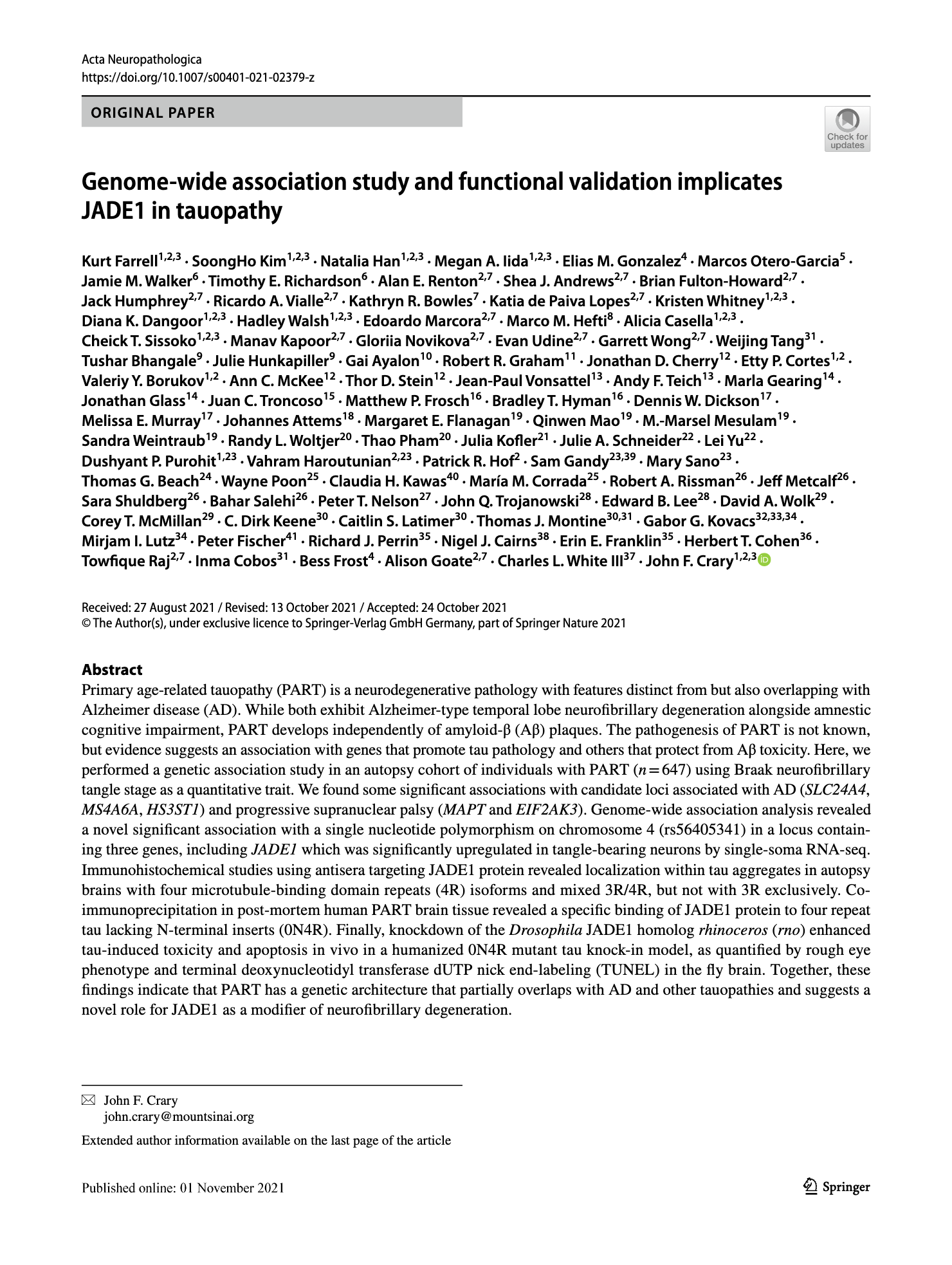 Genome-wide association study and functional validation implicates JADE1 in tauopathyKurt Farrell, SoongHo Kim, Natalia Han, and 86 more authorsActa Neuropathologica, 2022
Genome-wide association study and functional validation implicates JADE1 in tauopathyKurt Farrell, SoongHo Kim, Natalia Han, and 86 more authorsActa Neuropathologica, 2022Primary age-related tauopathy (PART) is a neurodegenerative pathology with features distinct from but also overlapping with Alzheimer disease (AD). While both exhibit Alzheimer-type temporal lobe neurofibrillary degeneration alongside amnestic cognitive impairment, PART develops independently of amyloid-β (Aβ) plaques. The pathogenesis of PART is not known, but evidence suggests an association with genes that promote tau pathology and others that protect from Aβ toxicity. Here, we performed a genetic association study in an autopsy cohort of individuals with PART (n = 647) using Braak neurofibrillary tangle stage as a quantitative trait. We found some significant associations with candidate loci associated with AD (SLC24A4, MS4A6A, HS3ST1) and progressive supranuclear palsy (MAPT and EIF2AK3). Genome-wide association analysis revealed a novel significant association with a single nucleotide polymorphism on chromosome 4 (rs56405341) in a locus containing three genes, including JADE1 which was significantly upregulated in tangle-bearing neurons by single-soma RNA-seq. Immunohistochemical studies using antisera targeting JADE1 protein revealed localization within tau aggregates in autopsy brains with four microtubule-binding domain repeats (4R) isoforms and mixed 3R/4R, but not with 3R exclusively. Co-immunoprecipitation in post-mortem human PART brain tissue revealed a specific binding of JADE1 protein to four repeat tau lacking N-terminal inserts (0N4R). Finally, knockdown of the Drosophila JADE1 homolog rhinoceros (rno) enhanced tau-induced toxicity and apoptosis in vivo in a humanized 0N4R mutant tau knock-in model, as quantified by rough eye phenotype and terminal deoxynucleotidyl transferase dUTP nick end-labeling (TUNEL) in the fly brain. Together, these findings indicate that PART has a genetic architecture that partially overlaps with AD and other tauopathies and suggests a novel role for JADE1 as a modifier of neurofibrillary degeneration.
-
 A Mitochondrial DNA Haplogroup Defines Patterns of Five-Year Cognitive ChangeAmber Watts, Prabhakar Chalise, Jinxiang Hu, and 5 more authorsJournal of Alzheimer’s Disease, 2022
A Mitochondrial DNA Haplogroup Defines Patterns of Five-Year Cognitive ChangeAmber Watts, Prabhakar Chalise, Jinxiang Hu, and 5 more authorsJournal of Alzheimer’s Disease, 2022Background: Mitochondrial DNA (mtDNA) may play a role in Alzheimer’s disease (AD) and cognitive decline. A particular haplogroup of mtDNA, haplogroup J, has been observed more commonly in patients with AD than in cognitively normal controls. Objective: We used two mtDNA haplogroups, H and J, to predict change in cognitive performance over five years. We hypothesized that haplogroup J carriers would show less cognitive resilience. Methods: We analyzed data from 140 cognitively normal older adults who participated in the University of Kansas Alzheimer’s Disease Research Center clinical cohort between 2011 and 2020. We used factor analysis to create three composite scores (verbal memory, attention, and executive function) from 11 individual cognitive tests. We performed latent growth curve modeling to describe trajectories of cognitive performance and change adjusting for age, sex, years of education, and APOE ɛ4 allele carrier status. We compared haplogroup H, the most common group, to haplogroup J, the potential risk group. Results: Haplogroup J carriers had significantly lower baseline performance and slower rates of improvement on tests of verbal memory compared to haplogroup H carriers. We did not observe differences in executive function or attention. Conclusion: Our results reinforce the role of mtDNA in changes to cognitive function in a domain associated with risk for dementia, verbal memory, but not with other cognitive domains. Future research should investigate the distinct mechanisms by which mtDNA might affect performance on verbal memory as compared to other cognitive domains across haplogroups.
-
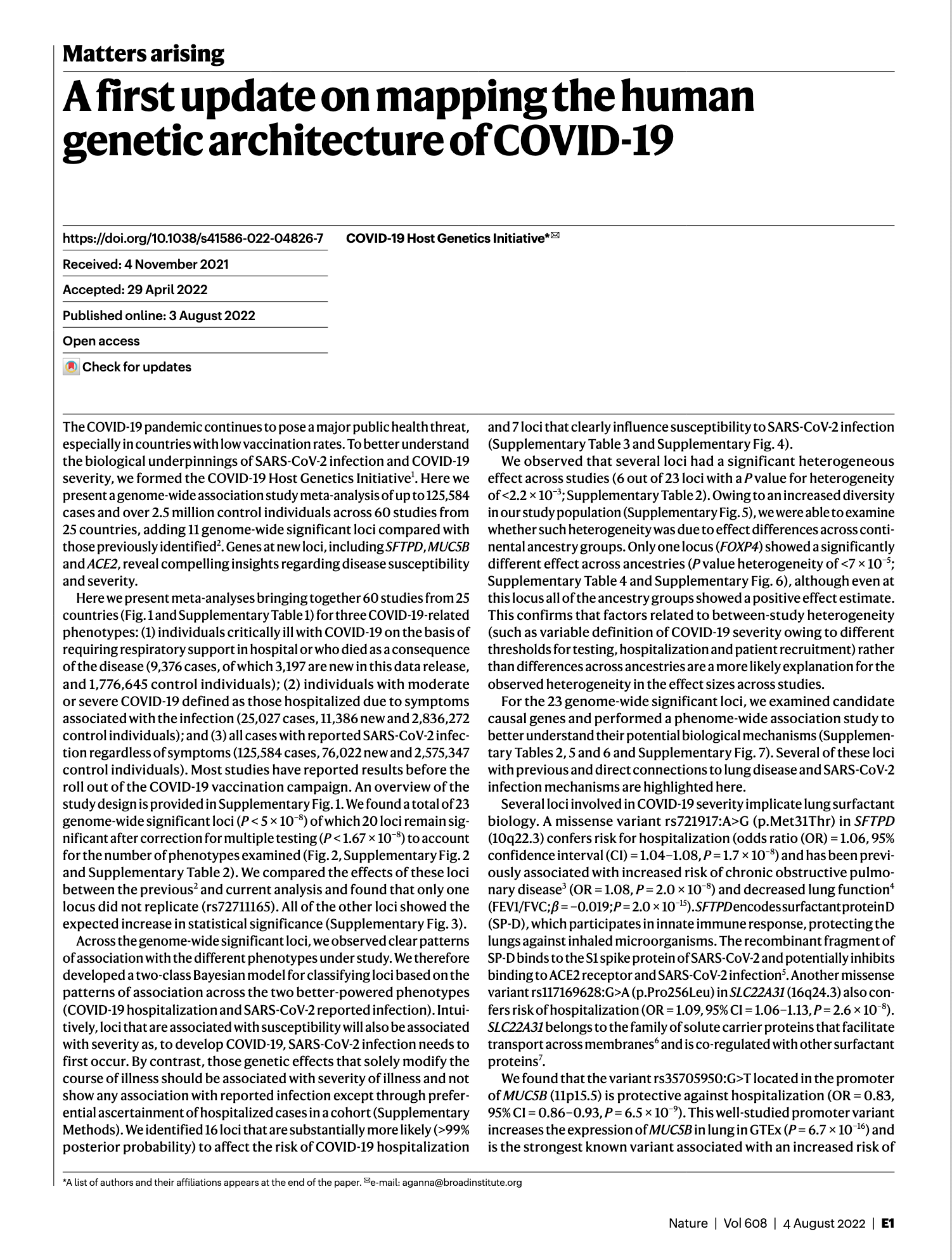 A first update on mapping the human genetic architecture of COVID-19COVID-19 Host Genetics Initiative, Leadership, Gita A Pathak, and 901 more authorsNature, 2022
A first update on mapping the human genetic architecture of COVID-19COVID-19 Host Genetics Initiative, Leadership, Gita A Pathak, and 901 more authorsNature, 2022
2021
-
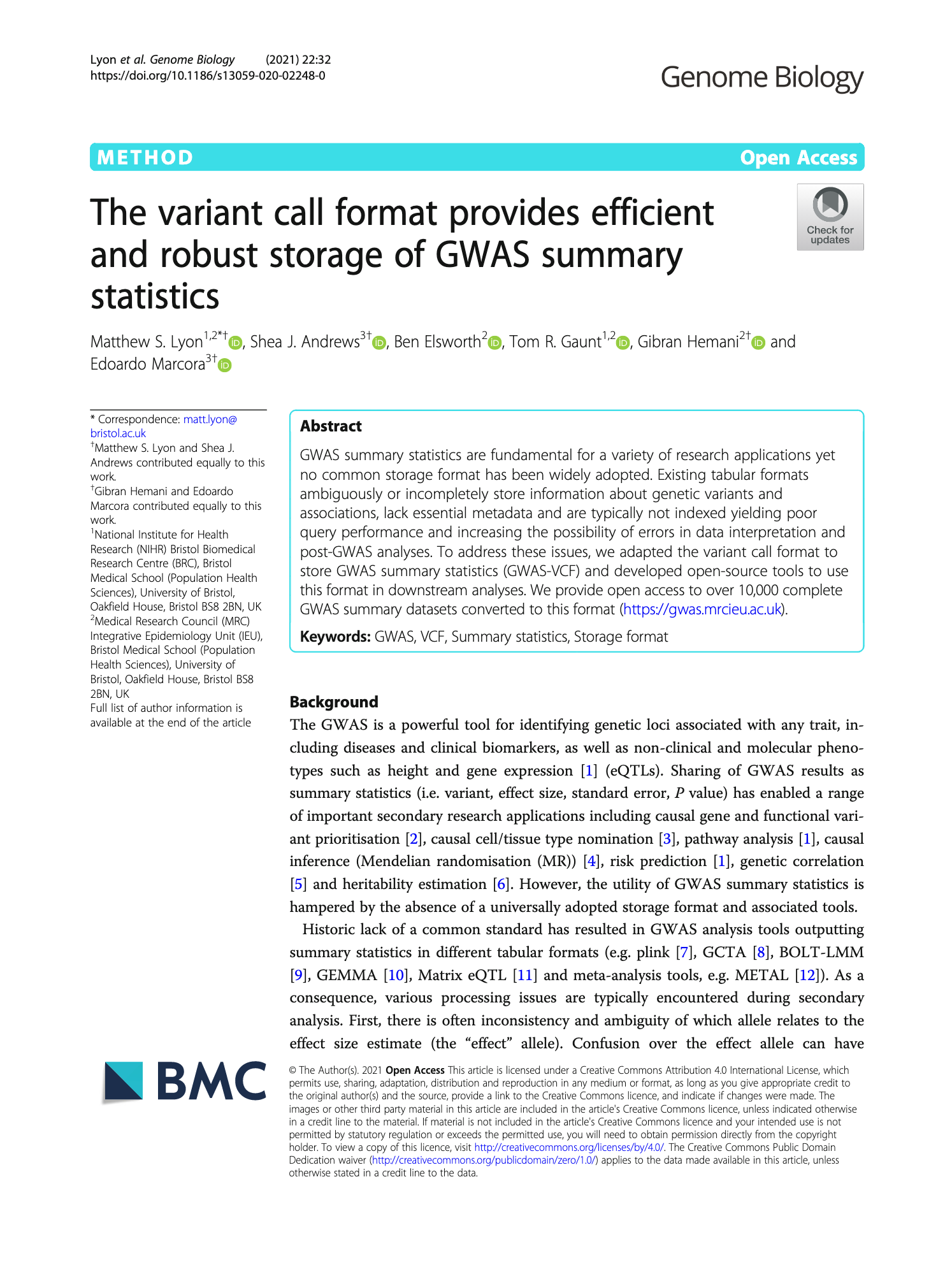 The variant call format provides efficient and robust storage of GWAS summary statisticsMatthew S. Lyon, Shea J. Andrews, Ben Elsworth, and 3 more authorsGenome Biology, 2021
The variant call format provides efficient and robust storage of GWAS summary statisticsMatthew S. Lyon, Shea J. Andrews, Ben Elsworth, and 3 more authorsGenome Biology, 2021GWAS summary statistics are fundamental for a variety of research applications yet no common storage format has been widely adopted. Existing tabular formats ambiguously or incompletely store information about genetic variants and associations, lack essential metadata and are typically not indexed yielding poor query performance and increasing the possibility of errors in data interpretation and post-GWAS analyses. To address these issues, we adapted the variant call format to store GWAS summary statistics (GWAS-VCF) and developed open-source tools to use this format in downstream analyses. We provide open access to over 10,000 complete GWAS summary datasets converted to this format (https://gwas.mrcieu.ac.uk).
-
 Shared genetic etiology between idiopathic pulmonary fibrosis and COVID-19 severityJoão Fadista, Luke M. Kraven, Juha Karjalainen, and 7 more authorsEBioMedicine, 2021
Shared genetic etiology between idiopathic pulmonary fibrosis and COVID-19 severityJoão Fadista, Luke M. Kraven, Juha Karjalainen, and 7 more authorsEBioMedicine, 2021Background Idiopathic pulmonary fibrosis (IPF) is a complex lung disease, characterized by progressive lung scarring. Severe COVID-19 is associated with substantial pneumonitis and has a number of shared major risk factors with IPF. This study aimed to determine the genetic correlation between IPF and severe COVID-19 and assess a potential causal role of genetically increased risk of IPF on COVID-19 severity. Methods The genetic correlation between IPF and COVID-19 severity was estimated with linkage disequilibrium (LD) score regression. We performed a Mendelian randomization (MR) study for IPF causality in COVID-19. Genetic variants associated with IPF susceptibility (P<5 × 10−8) in previous genome-wide association studies (GWAS) were used as instrumental variables (IVs). Effect estimates of those IVs on COVID-19 severity were gathered from the GWAS meta-analysis by the COVID-19 Host Genetics Initiative (4,336 cases & 623,902 controls). Findings We detected a positive genetic correlation of IPF with COVID-19 severity (rg=0·31 [95% CI 0·04–0·57], P = 0·023). The MR estimates for severe COVID-19 did not reveal any genetic association (OR 1·05, [95% CI 0·92–1·20], P = 0·43). However, outlier analysis revealed that the IPF risk allele rs35705950 at MUC5B had a different effect compared with the other variants. When rs35705950 was excluded, MR results provided evidence that genetically increased risk of IPF has a causal effect on COVID-19 severity (OR 1·21, [95% CI 1·06–1·38], P = 4·24 × 10−3). Furthermore, the IPF risk-allele at MUC5B showed an apparent protective effect against COVID-19 hospitalization only in older adults (OR 0·86, [95% CI 0·73–1·00], P = 2·99 × 10−2) . Interpretation The strongest genetic determinant of IPF, rs35705950 at MUC5B, seems to confer protection against COVID-19, whereas the combined effect of all other IPF risk loci seem to confer risk of COVID-19 severity. The observed effect of rs35705950 could either be due to protective effects of mucin over-production on the airways or a consequence of selection bias due to (1) a patient group that is heavily enriched for the rs35705950 T undertaking strict self-isolation and/or (2) due to survival bias of the rs35705950 non-IPF risk allele carriers. Due to the diverse impact of IPF causal variants on SARS-CoV-2 infection, with a possible selection bias as an explanation, further investigation is needed to address this apparent paradox between variance at MUC5B and other IPF genetic risk factors. Funding Novo Nordisk Foundation and Oak Foundation.
-
 Mitochondrial pathway polygenic risk scores are associated with Alzheimer’s DiseaseDevashi Paliwal, Tim W. McInerney, Judy Pa, and 4 more authorsNeurobiology of Aging, 2021
Mitochondrial pathway polygenic risk scores are associated with Alzheimer’s DiseaseDevashi Paliwal, Tim W. McInerney, Judy Pa, and 4 more authorsNeurobiology of Aging, 2021Genetic, animal and epidemiological studies involving biomolecular and clinical endophenotypes implicate mitochondrial dysfunction in Alzheimer’s disease (AD) pathogenesis. Polygenic risk scores (PRS) provide a novel approach to assess biological pathway-associated disease risk by combining the effects of variation at multiple, functionally related genes. We investigated the associations of PRS for genes involved in 12 mitochondrial pathways (pathway-PRS) with AD in 854 participants from Alzheimer’s Disease Neuroimaging Initiative. Pathway-PRS for the nuclear-encoded mitochondrial genome (OR: 1.99 [95% Cl: 1.70, 2.35]) and three mitochondrial pathways is significantly associated with increased AD risk: (i) response to oxidative stress (OR: 2.01 [95% Cl: 1.71, 2.38]); (ii) mitochondrial transport (OR: 1.81 [95% Cl: 1.55, 2.13]); (iii) hallmark oxidative phosphorylation (OR: 1.22 [95% Cl: 1.06, 1.40]. Therapeutic approaches targeting these pathways may have the potential for modifying AD pathogenesis. Further investigation is required to establish a causal role for these pathways in AD pathology.
-
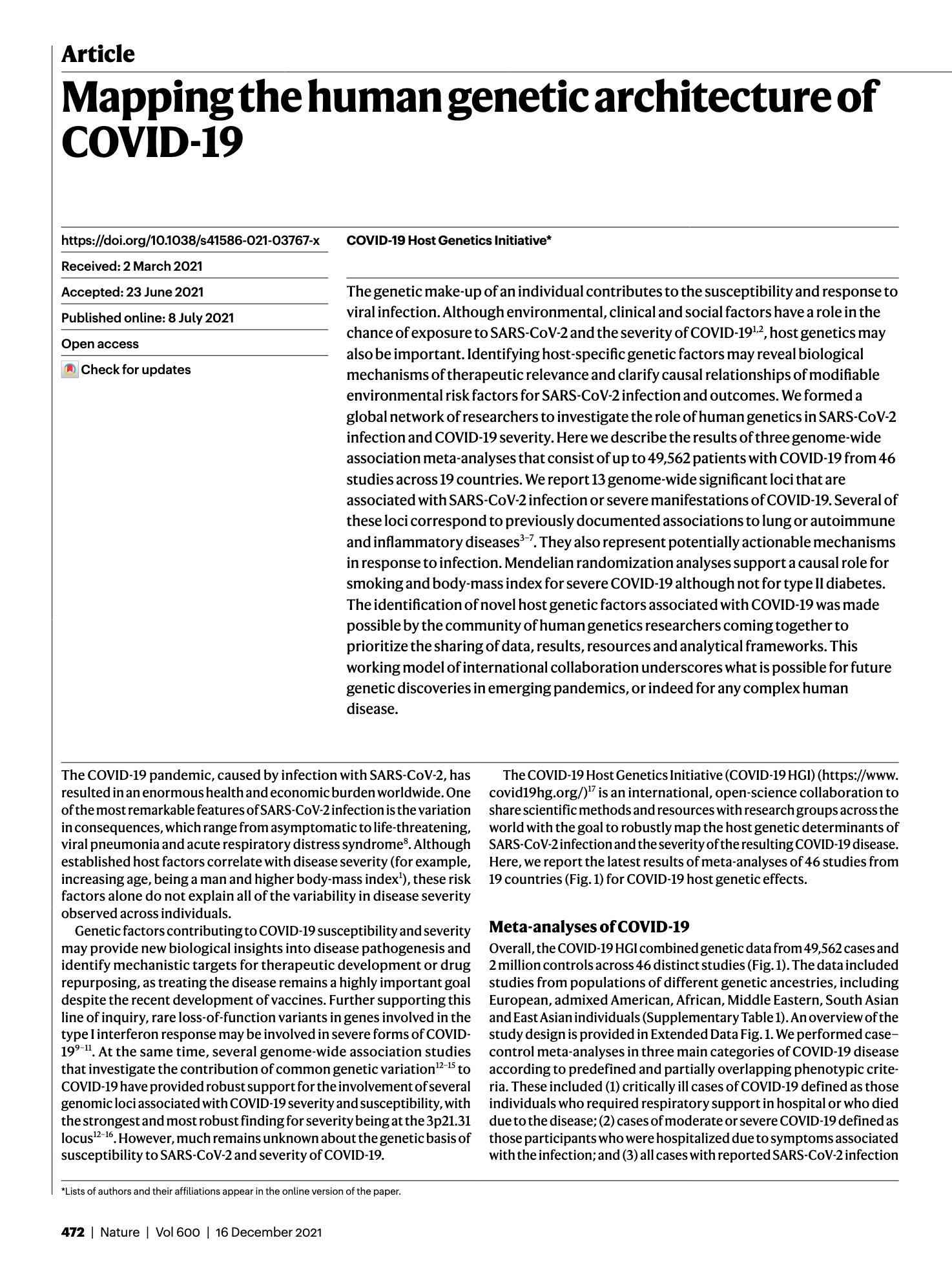 Mapping the human genetic architecture of COVID-19COVID-19 Host Genetics Initiative, COVID-19 Host Genetics InitiativeLeadership, Mari E K Niemi, and 3609 more authorsNature, 2021
Mapping the human genetic architecture of COVID-19COVID-19 Host Genetics Initiative, COVID-19 Host Genetics InitiativeLeadership, Mari E K Niemi, and 3609 more authorsNature, 2021The genetic make-up of an individual contributes to the susceptibility and response to viral infection. Although environmental, clinical and social factors have a role in the chance of exposure to SARS-CoV-2 and the severity of COVID-191,2, host genetics may also be important. Identifying host-specific genetic factors may reveal biological mechanisms of therapeutic relevance and clarify causal relationships of modifiable environmental risk factors for SARS-CoV-2 infection and outcomes. We formed a global network of researchers to investigate the role of human genetics in SARS-CoV-2 infection and COVID-19 severity. Here we describe the results of three genome-wide association meta-analyses that consist of up to 49,562 patients with COVID-19 from 46 studies across 19 countries. We report 13 genome-wide significant loci that are associated with SARS-CoV-2 infection or severe manifestations of COVID-19. Several of these loci correspond to previously documented associations to lung or autoimmune and inflammatory diseases3–7. They also represent potentially actionable mechanisms in response to infection. Mendelian randomization analyses support a causal role for smoking and body-mass index for severe COVID-19 although not for type II diabetes. The identification of novel host genetic factors associated with COVID-19 was made possible by the community of human genetics researchers coming together to prioritize the sharing of data, results, resources and analytical frameworks. This working model of international collaboration underscores what is possible for future genetic discoveries in emerging pandemics, or indeed for any complex human disease. A global network of researchers was formed to investigate the role of human genetics in SARS-CoV-2 infection and COVID-19 severity; this paper reports 13 genome-wide significant loci and potentially actionable mechanisms in response to infection.
-
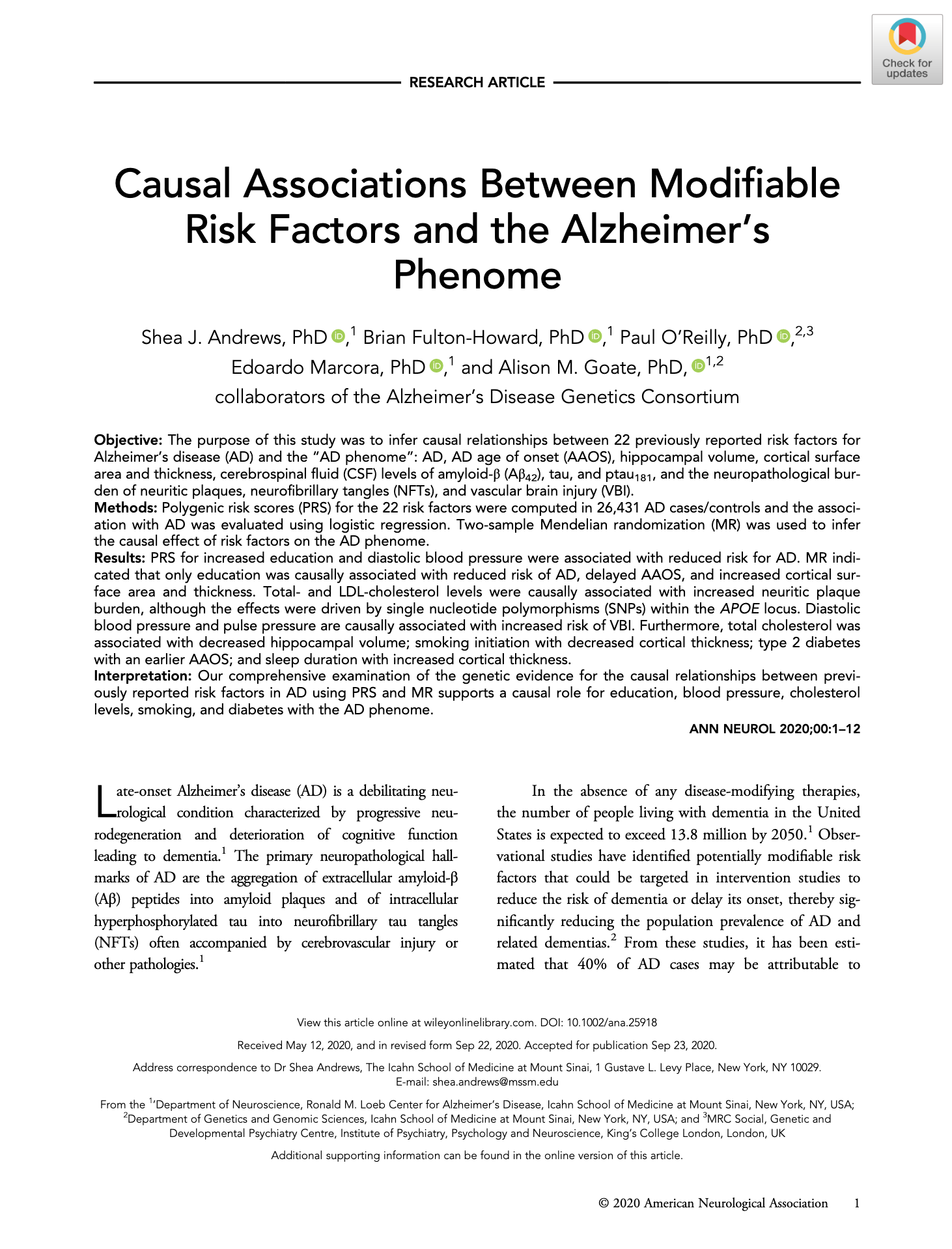 Causal Associations Between Modifiable Risk Factors and the Alzheimer’s PhenomeShea J Andrews, Brian Fulton‐Howard, Paul O’Reilly, and 9 more authorsAnnals of Neurology, 2021
Causal Associations Between Modifiable Risk Factors and the Alzheimer’s PhenomeShea J Andrews, Brian Fulton‐Howard, Paul O’Reilly, and 9 more authorsAnnals of Neurology, 2021The purpose of this study was to infer causal relationships between 22 previously reported risk factors for Alzheimer’s disease (AD) and the “AD phenome”: AD, AD age of onset (AAOS), hippocampal volume, cortical surface area and thickness, cerebrospinal fluid (CSF) levels of amyloid‐β (Aβ42), tau, and ptau181, and the neuropathological burden of neuritic plaques, neurofibrillary tangles (NFTs), and vascular brain injury (VBI). Polygenic risk scores (PRS) for the 22 risk factors were computed in 26,431 AD cases/controls and the association with AD was evaluated using logistic regression. Two‐sample Mendelian randomization (MR) was used to infer the causal effect of risk factors on the AD phenome. PRS for increased education and diastolic blood pressure were associated with reduced risk for AD. MR indicated that only education was causally associated with reduced risk of AD, delayed AAOS, and increased cortical surface area and thickness. Total‐ and LDL‐cholesterol levels were causally associated with increased neuritic plaque burden, although the effects were driven by single nucleotide polymorphisms (SNPs) within the APOE locus. Diastolic blood pressure and pulse pressure are causally associated with increased risk of VBI. Furthermore, total cholesterol was associated with decreased hippocampal volume; smoking initiation with decreased cortical thickness; type 2 diabetes with an earlier AAOS; and sleep duration with increased cortical thickness. Our comprehensive examination of the genetic evidence for the causal relationships between previously reported risk factors in AD using PRS and MR supports a causal role for education, blood pressure, cholesterol levels, smoking, and diabetes with the AD phenome. ANN NEUROL 2021;89:54–65
-
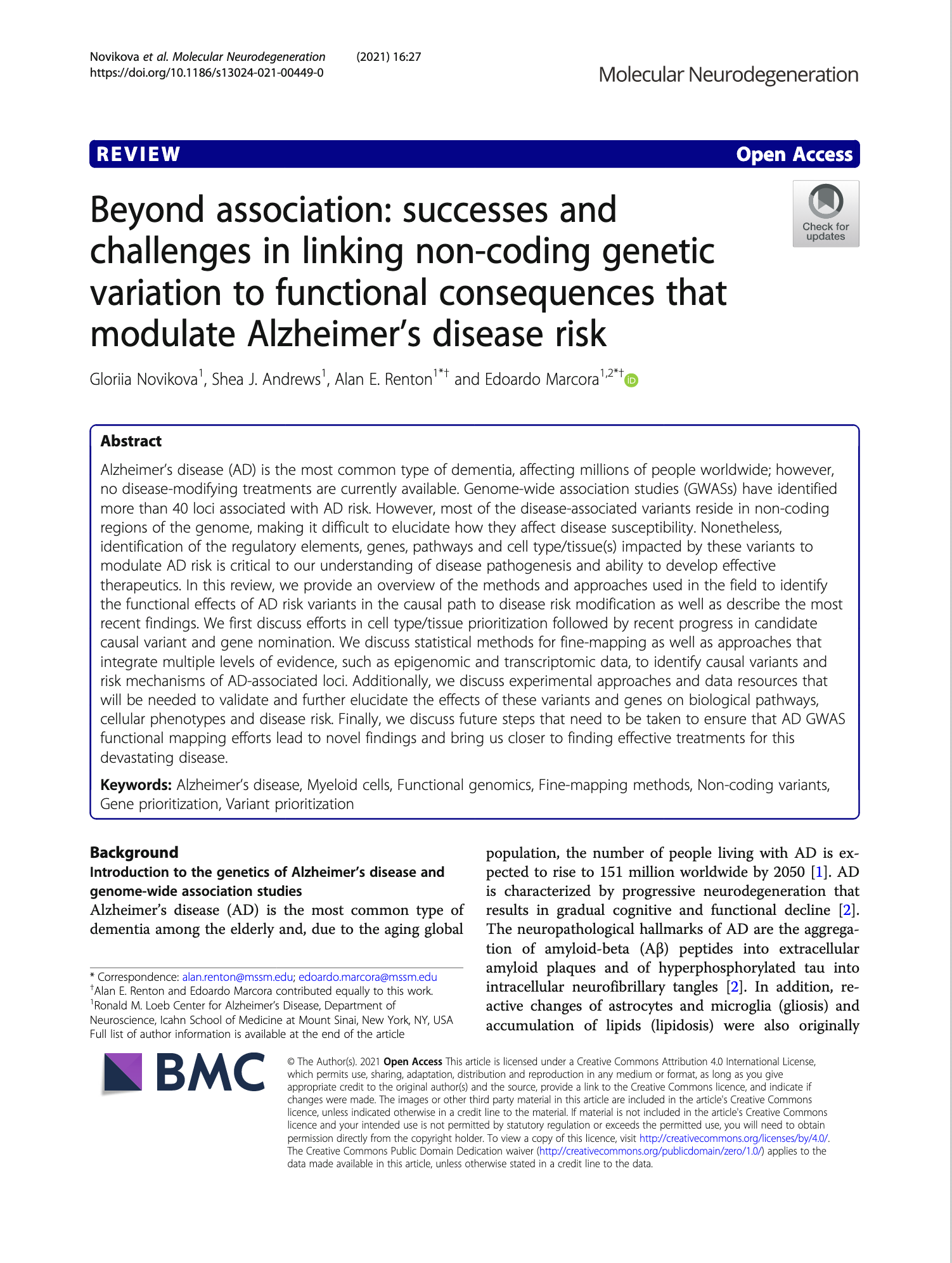 Beyond association: successes and challenges in linking non-coding genetic variation to functional consequences that modulate Alzheimer’s disease riskGloriia Novikova, Shea J. Andrews, Alan E. Renton, and 1 more authorMolecular Neurodegeneration, 2021
Beyond association: successes and challenges in linking non-coding genetic variation to functional consequences that modulate Alzheimer’s disease riskGloriia Novikova, Shea J. Andrews, Alan E. Renton, and 1 more authorMolecular Neurodegeneration, 2021Alzheimer’s disease (AD) is the most common type of dementia, affecting millions of people worldwide; however, no disease-modifying treatments are currently available. Genome-wide association studies (GWASs) have identified more than 40 loci associated with AD risk. However, most of the disease-associated variants reside in non-coding regions of the genome, making it difficult to elucidate how they affect disease susceptibility. Nonetheless, identification of the regulatory elements, genes, pathways and cell type/tissue(s) impacted by these variants to modulate AD risk is critical to our understanding of disease pathogenesis and ability to develop effective therapeutics. In this review, we provide an overview of the methods and approaches used in the field to identify the functional effects of AD risk variants in the causal path to disease risk modification as well as describe the most recent findings. We first discuss efforts in cell type/tissue prioritization followed by recent progress in candidate causal variant and gene nomination. We discuss statistical methods for fine-mapping as well as approaches that integrate multiple levels of evidence, such as epigenomic and transcriptomic data, to identify causal variants and risk mechanisms of AD-associated loci. Additionally, we discuss experimental approaches and data resources that will be needed to validate and further elucidate the effects of these variants and genes on biological pathways, cellular phenotypes and disease risk. Finally, we discuss future steps that need to be taken to ensure that AD GWAS functional mapping efforts lead to novel findings and bring us closer to finding effective treatments for this devastating disease.
-
 A globally diverse reference alignment and panel for imputation of mitochondrial DNA variantsTim W McInerney, Brian Fulton-Howard, Christopher Patterson, and 9 more authorsBMC Bioinformatics, 2021
A globally diverse reference alignment and panel for imputation of mitochondrial DNA variantsTim W McInerney, Brian Fulton-Howard, Christopher Patterson, and 9 more authorsBMC Bioinformatics, 2021Variation in mitochondrial DNA (mtDNA) identified by genotyping microarrays or by sequencing only the hypervariable regions of the genome may be insufficient to reliably assign mitochondrial genomes to phylogenetic lineages or haplogroups. This lack of resolution can limit functional and clinical interpretation of a substantial body of existing mtDNA data. To address this limitation, we developed and evaluated a large, curated reference alignment of complete mtDNA sequences as part of a pipeline for imputing missing mtDNA single nucleotide variants (mtSNVs). We call our reference alignment and pipeline MitoImpute. We aligned the sequences of 36,960 complete human mitochondrial genomes downloaded from GenBank, filtered and controlled for quality. These sequences were reformatted for use in imputation software, IMPUTE2. We assessed the imputation accuracy of MitoImpute by measuring haplogroup and genotype concordance in data from the 1000 Genomes Project and the Alzheimer’s Disease Neuroimaging Initiative (ADNI). The mean improvement of haplogroup assignment in the 1000 Genomes samples was 42.7% (Matthew’s correlation coefficient = 0.64). In the ADNI cohort, we imputed missing single nucleotide variants. These results show that our reference alignment and panel can be used to impute missing mtSNVs in existing data obtained from using microarrays, thereby broadening the scope of functional and clinical investigation of mtDNA. This improvement may be particularly useful in studies where participants have been recruited over time and mtDNA data obtained using different methods, enabling better integration of early data collected using less accurate methods with more recent sequence data.
2020
-
 Role of apolipoprotein E epsilon 4 (APOE*ε4) as an independent risk factor for incident depression over a 12-year period in cognitively intact adults across the lifespanRichard Andrew Burns, Shea Andrews, Nicolas Cherbuin, and 1 more authorBJPsych Open, 2020
Role of apolipoprotein E epsilon 4 (APOE*ε4) as an independent risk factor for incident depression over a 12-year period in cognitively intact adults across the lifespanRichard Andrew Burns, Shea Andrews, Nicolas Cherbuin, and 1 more authorBJPsych Open, 2020The apolipoprotein E ε4 allele (APOE*ε4) is indicated as a risk for Alzheimer’s disease and other age-related diseases. The risk attributable to APOE*ε4 for depression is less clear and may be because of confounding of the relationship between dementia and depression. We examined the risk of APOE* ε4 for incident depression and depressive symptomology over a 12-year period across the adult lifespan. Participants were from the Personality and Total Health Through Life study, aged 20 to 24 (n = 1420), 40 to 44 (n = 1592) or 60–64 (n = 1768) at baseline, and interviewed every 4 years since 1999. Ethnicities other than White, those without genotyping and those with depression at baseline, or who reported strokes and scores on the Mini-Mental State Examination <27 at any observation, were excluded. Over the study period, there was no evidence that APOE*ε4+ was a risk factor for depression, including any depression (odds ratio (OR) = 0.94, 95% CI 0.77–1.16, P = 0.573), major depression (OR = 0.96, 95% CI 0.60–1.53, P = 0.860), minor depression (OR = 0.94, 95% CI 0.67–1.30, P = 0.695) or depressive symptomology (incidence rate ratio (IRR) = 1.02, 95% CI 0.97–1.08, P = 0.451). APOE*ε4 was unrelated to incident depression. Findings were consistent for all age cohorts. Among cognitively intact Australian adults who were free of depression at baseline, there was little evidence that APOE*ε4+ carriers are at increased risk for depression over a 12-year period among those who are cognitively intact.
-
 Mitonuclear interactions influence Alzheimer’s disease riskShea J. Andrews, Brian Fulton-Howard, Christopher Patterson, and 7 more authorsNeurobiology of Aging, 2020
Mitonuclear interactions influence Alzheimer’s disease riskShea J. Andrews, Brian Fulton-Howard, Christopher Patterson, and 7 more authorsNeurobiology of Aging, 2020We examined the associations between mitochondrial DNA haplogroups (MT-hgs; mitochondrial haplotype groups defined by a specific combination of single nucleotide polymorphisms labeled as letters running from A to Z) and their interactions with a polygenic risk score composed of nuclear-encoded mitochondrial genes (nMT-PRS) with risk of dementia and age of onset (AOO) of dementia. MT-hg K (Odds ratio [OR]: 2.03 [95% CI: 1.04, 3.97]) and a 1 SD larger nMT-PRS (OR: 2.2 [95% CI: 1.68, 2.86]) were associated with elevated odds of dementia. Significant antagonistic interactions between the nMT-PRS and MT-hg K (OR: 0.45 [95% CI: 0.22, 0.9]) and MT-hg T (OR: 0.22 [95% CI: 0.1, 0.49]) were observed. Individual MT-hgs were not associated with AOO; however, a significant antagonistic interactions was observed between the nMT-PRS and MT-hg T (Hazard ratio: 0.62 [95% CI: 0.42, 0.91]) and a synergistic interaction between the nMT-PRS and MT-hg V (Hazard ratio: 2.28 [95% CI: 1.19, 4.35]). These results suggest that MT-hgs influence dementia risk and that variants in the nuclear and mitochondrial genome interact to influence the AOO of dementia.
-
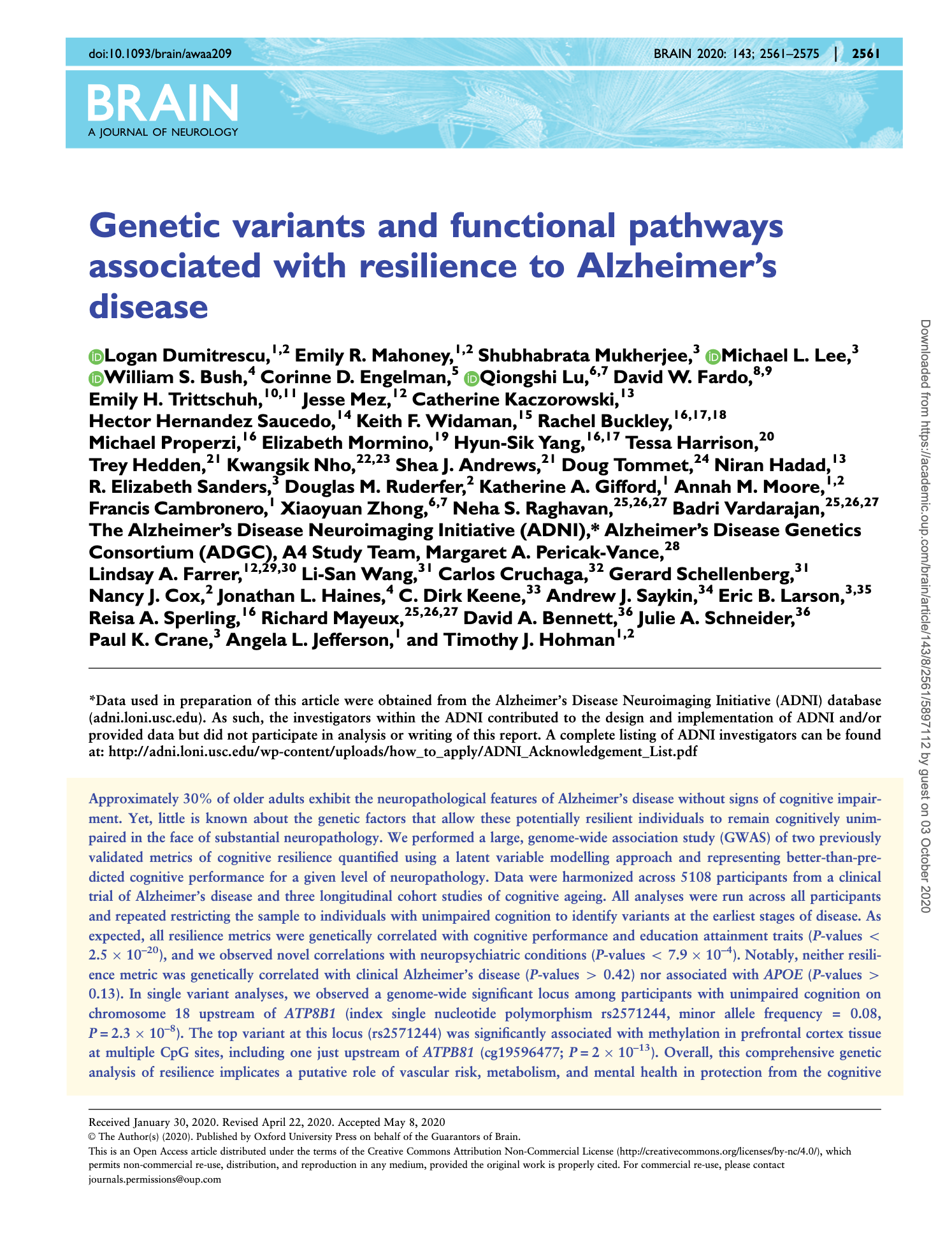 Genetic variants and functional pathways associated with resilience to Alzheimer’s diseaseLogan Dumitrescu, Emily R Mahoney, Shubhabrata Mukherjee, and 47 more authorsBrain, 2020
Genetic variants and functional pathways associated with resilience to Alzheimer’s diseaseLogan Dumitrescu, Emily R Mahoney, Shubhabrata Mukherjee, and 47 more authorsBrain, 2020Approximately 30% of older adults exhibit the neuropathological features of Alzheimer’s disease without signs of cognitive impairment. Yet, little is known about the genetic factors that allow these potentially resilient individuals to remain cognitively unimpaired in the face of substantial neuropathology. We performed a large, genome-wide association study (GWAS) of two previously validated metrics of cognitive resilience quantified using a latent variable modelling approach and representing better-than-predicted cognitive performance for a given level of neuropathology. Data were harmonized across 5108 participants from a clinical trial of Alzheimer’s disease and three longitudinal cohort studies of cognitive ageing. All analyses were run across all participants and repeated restricting the sample to individuals with unimpaired cognition to identify variants at the earliest stages of disease. As expected, all resilience metrics were genetically correlated with cognitive performance and education attainment traits (P-values < 2.5 × 10−20), and we observed novel correlations with neuropsychiatric conditions (P-values < 7.9 × 10−4). Notably, neither resilience metric was genetically correlated with clinical Alzheimer’s disease (P-values > 0.42) nor associated with APOE (P-values > 0.13). In single variant analyses, we observed a genome-wide significant locus among participants with unimpaired cognition on chromosome 18 upstream of ATP8B1 (index single nucleotide polymorphism rs2571244, minor allele frequency = 0.08, P = 2.3 × 10−8). The top variant at this locus (rs2571244) was significantly associated with methylation in prefrontal cortex tissue at multiple CpG sites, including one just upstream of ATPB81 (cg19596477; P = 2 × 10−13). Overall, this comprehensive genetic analysis of resilience implicates a putative role of vascular risk, metabolism, and mental health in protection from the cognitive consequences of neuropathology, while also providing evidence for a novel resilience gene along the bile acid metabolism pathway. Furthermore, the genetic architecture of resilience appears to be distinct from that of clinical Alzheimer’s disease, suggesting that a shift in focus to molecular contributors to resilience may identify novel pathways for therapeutic targets.
-
 Exploratory analysis of mtDNA haplogroups in two Alzheimer’s longitudinal cohortsRussell H. Swerdlow, Dongwei Hui, Prabhakar Chalise, and 11 more authorsAlzheimer’s & Dementia, 2020
Exploratory analysis of mtDNA haplogroups in two Alzheimer’s longitudinal cohortsRussell H. Swerdlow, Dongwei Hui, Prabhakar Chalise, and 11 more authorsAlzheimer’s & Dementia, 2020Inherited mitochondrial DNA (mtDNA) variants may influence Alzheimer’s disease (AD) risk. We sequenced mtDNA from 146 AD and 265 cognitively normal (CN) subjects from the University of Kansas AD Center (KUADC) and assigned haplogroups. We further considered 244 AD and 242 CN AD Neuroimaging Initiative (ADNI) subjects with equivalent data. Without applying multiple comparisons corrections, KUADC haplogroup J AD and CN frequencies were 16.4% versus 7.6% (P = .007), and haplogroup K AD and CN frequencies were 4.8% versus 10.2% (P = .063). ADNI haplogroup J AD and CN frequencies were 10.7% versus 7.0% (P = .20), and haplogroup K frequencies were 4.9% versus 8.7% (P = .11). For the combined 390 AD and 507 CN cases haplogroup J frequencies were 12.8% versus 7.3% (P = .006), odds ratio (OR) = 1.87, and haplogroup K frequencies were 4.9% versus 9.5% (P = .010), OR = 0.49. Associations remained significant after adjusting for apolipoprotein E, age, and sex. This exploratory analysis suggests inherited mtDNA variants influence AD risk.
2019
-
 Protective Variants in Alzheimer’s DiseaseShea J. Andrews, Brian Fulton-Howard, and Alison GoateCurrent Genetic Medicine Reports, 2019
Protective Variants in Alzheimer’s DiseaseShea J. Andrews, Brian Fulton-Howard, and Alison GoateCurrent Genetic Medicine Reports, 2019Over the last decade, over 40 loci have been associated with risk of Alzheimer’s disease (AD). However, most studies have either focused on identifying risk loci or performing unbiased screens without a focus on protective variation in AD. Here, we provide a review of known protective variants in AD and their putative mechanisms of action. Additionally, we recommend strategies for finding new protective variants. Recent Genome-Wide Association Studies have identified both common and rare protective variants associated with AD. These include variants in or near APP, APOE, PLCG2, MS4A, MAPT-KANSL1, RAB10, ABCA1, CCL11, SORL1, NOCT, SCL24A4-RIN3, CASS4, EPHA1, SPPL2A, and NFIC. There are very few protective variants with functional evidence and a derived allele with a frequency below 20%. Additional fine mapping and multi-omic studies are needed to further validate and characterize known variants as well as specialized genome-wide scans to identify novel variants.
-
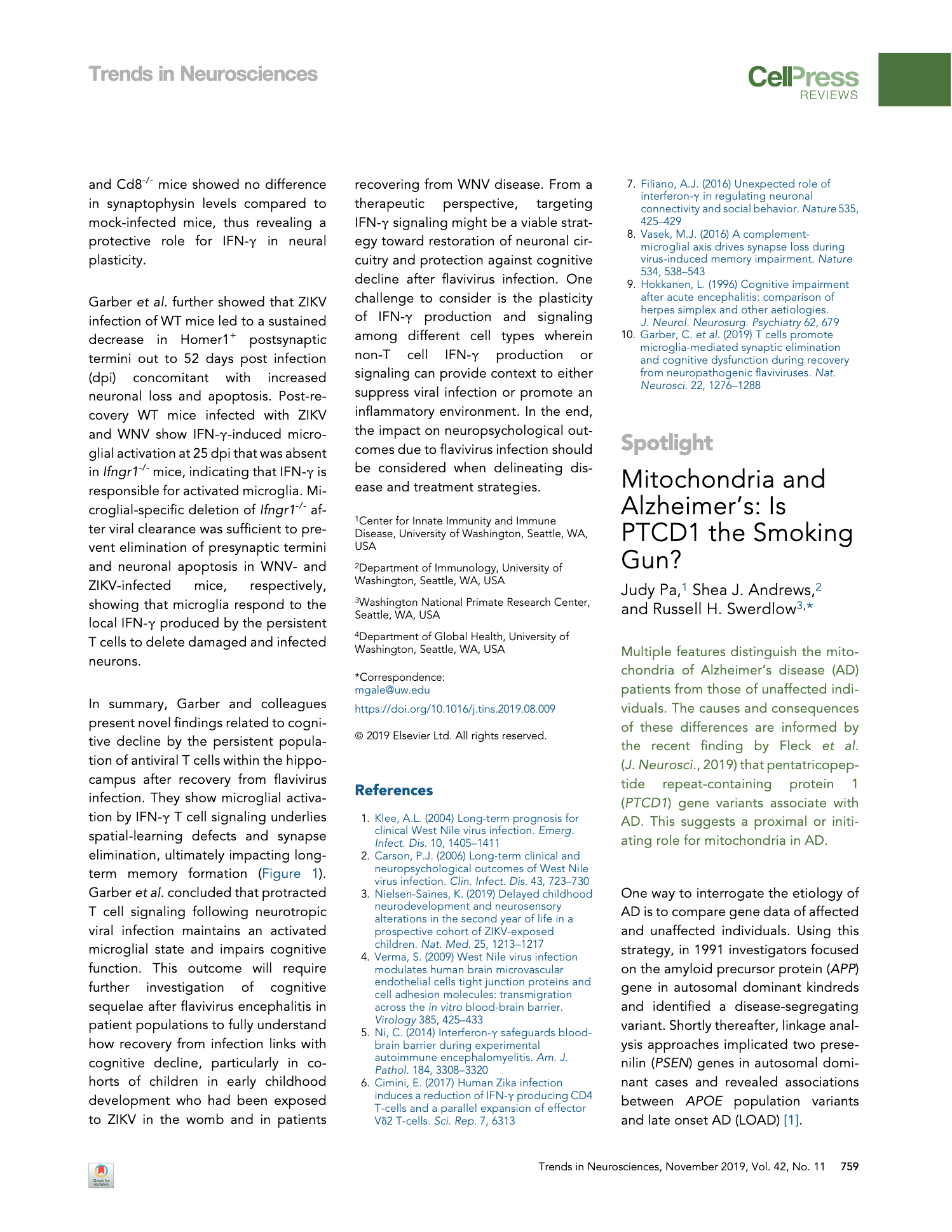 Mitochondria and Alzheimer’s: Is PTCD1 the Smoking Gun?Judy Pa, Shea J. Andrews, and Russell H. SwerdlowTrends in Neurosciences, 2019
Mitochondria and Alzheimer’s: Is PTCD1 the Smoking Gun?Judy Pa, Shea J. Andrews, and Russell H. SwerdlowTrends in Neurosciences, 2019Multiple features distinguish the mitochondria of Alzheimer’s disease (AD) patients from those of unaffected individuals. The causes and consequences of these differences are informed by the recent finding by Fleck et al. (J. Neurosci., 2019) that pentatricopeptide repeat-containing protein 1 (PTCD1) gene variants associate with AD. This suggests a proximal or initiating role for mitochondria in AD.
-
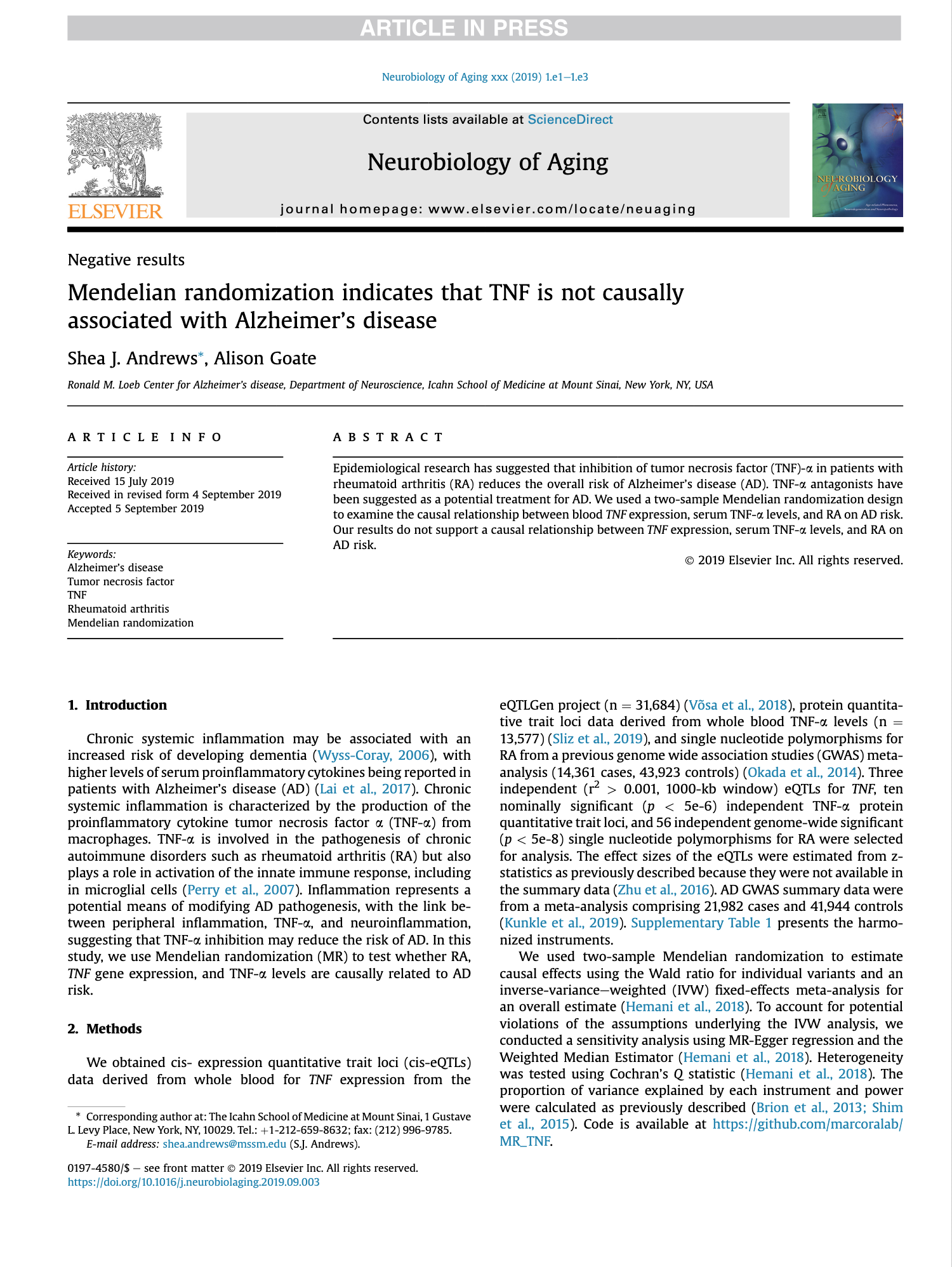 Mendelian randomization indicates that TNF is not causally associated with Alzheimer’s diseaseShea J. Andrews, and Alison GoateNeurobiology of Aging, 2019
Mendelian randomization indicates that TNF is not causally associated with Alzheimer’s diseaseShea J. Andrews, and Alison GoateNeurobiology of Aging, 2019Epidemiological research has suggested that inhibition of tumor necrosis factor (TNF)-α in patients with rheumatoid arthritis (RA) reduces the overall risk of Alzheimer’s disease (AD). TNF-α antagonists have been suggested as a potential treatment for AD. We used a two-sample Mendelian randomization design to examine the causal relationship between blood TNF expression, serum TNF-α levels, and RA on AD risk. Our results do not support a causal relationship between TNF expression, serum TNF-α levels, and RA on AD risk.
-
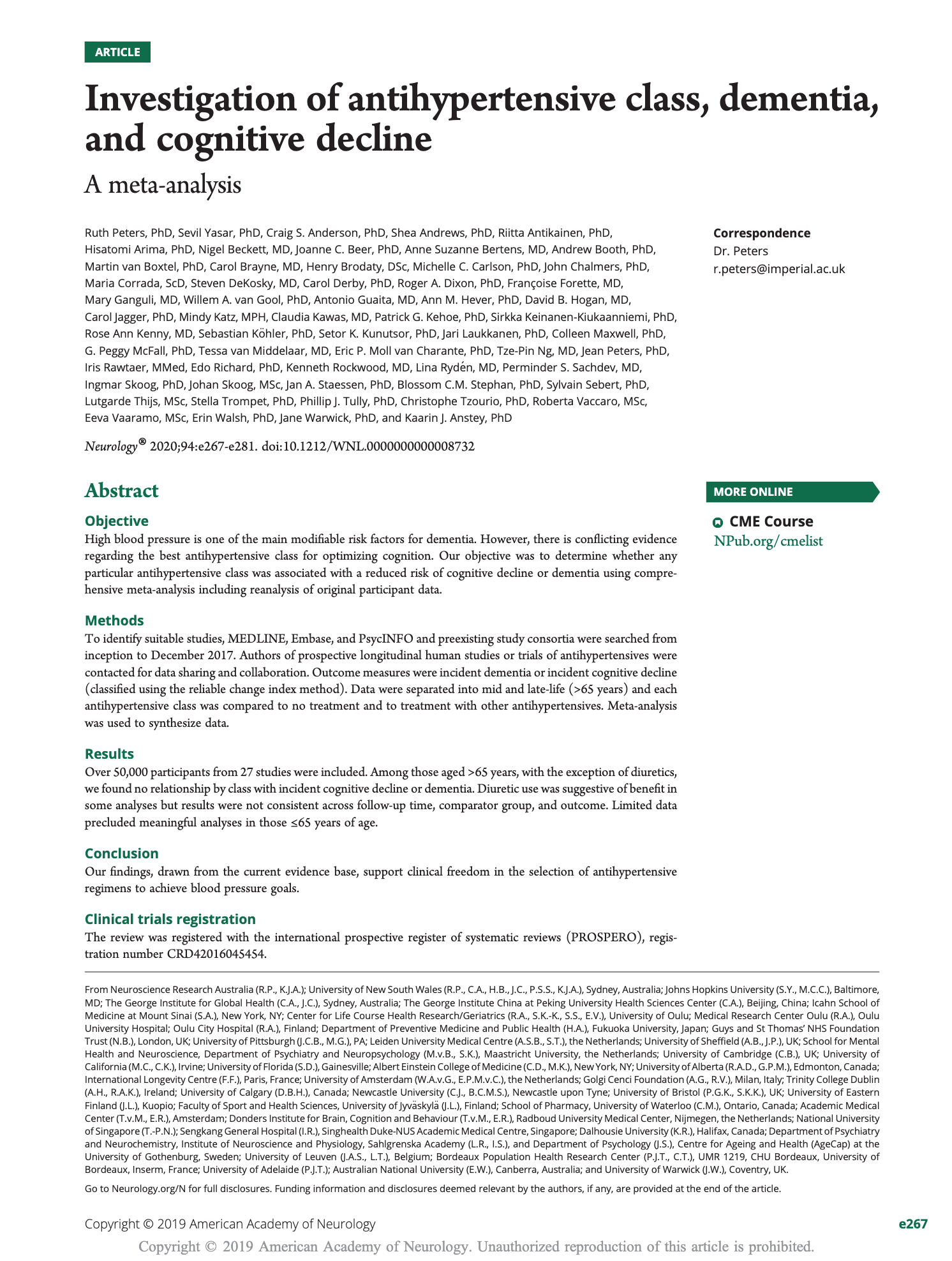 Investigation of antihypertensive class, dementia, and cognitive decline: A meta-analysisRuth Peters, Sevil Yasar, Craig S Anderson, and 56 more authorsNeurology, 2019
Investigation of antihypertensive class, dementia, and cognitive decline: A meta-analysisRuth Peters, Sevil Yasar, Craig S Anderson, and 56 more authorsNeurology, 2019Objective High blood pressure is one of the main modifiable risk factors for dementia. However, there is conflicting evidence regarding the best antihypertensive class for optimizing cognition. Our objective was to determine whether any particular antihypertensive class was associated with a reduced risk of cognitive decline or dementia using comprehensive meta-analysis including reanalysis of original participant data. Methods To identify suitable studies, MEDLINE, Embase, and PsycINFO and preexisting study consortia were searched from inception to December 2017. Authors of prospective longitudinal human studies or trials of antihypertensives were contacted for data sharing and collaboration. Outcome measures were incident dementia or incident cognitive decline (classified using the reliable change index method). Data were separated into mid and late-life (>65 years) and each antihypertensive class was compared to no treatment and to treatment with other antihypertensives. Meta-analysis was used to synthesize data. Results Over 50,000 participants from 27 studies were included. Among those aged >65 years, with the exception of diuretics, we found no relationship by class with incident cognitive decline or dementia. Diuretic use was suggestive of benefit in some analyses but results were not consistent across follow-up time, comparator group, and outcome. Limited data precluded meaningful analyses in those ≤65 years of age. Conclusion Our findings, drawn from the current evidence base, support clinical freedom in the selection of antihypertensive regimens to achieve blood pressure goals. Clinical trials registration The review was registered with the international prospective register of systematic reviews (PROSPERO), registration number CRD42016045454.
-
 Association of Alzheimer’s Disease Genetic Risk Loci with Cognitive Performance and Decline: A Systematic ReviewShea J Andrews, G Peggy McFall, Andrew Booth, and 2 more authorsJournal of Alzheimer’s Disease, 2019
Association of Alzheimer’s Disease Genetic Risk Loci with Cognitive Performance and Decline: A Systematic ReviewShea J Andrews, G Peggy McFall, Andrew Booth, and 2 more authorsJournal of Alzheimer’s Disease, 2019The association of Apolipoprotein E (APOE) with late-onset Alzheimer’s disease (LOAD) and cognitive endophenotypes of aging has been widely investigated. There is increasing interest in evaluating the association of other LOAD risk loci with cognitive performance and decline. The results of these studies have been inconsistent and inconclusive. We conducted a systematic review of studies investigating the association of non-APOE LOAD risk loci with cognitive performance in older adults. Studies published from January 2009 to April 2018 were identified through a PubMed database search using keywords and by scanning reference lists. Studies were included if they were either cross-sectional or longitudinal in design, included at least one genome-wide significant LOAD risk loci or a genetic risk score, and had one objective measure of cognition. Quality assessment of the studies was conducted using the quality of genetic studies (Q-Genie) tool. Of 2,466 studies reviewed, 49 met inclusion criteria. Fifteen percent of the associations between non-APOE LOAD risk loci and cognition were significant. However, these associations were not replicated across studies, and the majority were rendered non-significant when adjusting for multiple testing. One-third of the studies included genetic risk scores, and these were typically significant only when APOE was included. The findings of this systematic review do not support a consistent association between individual non-APOE LOAD risk and cognitive performance or decline. However, evidence suggests that aggregate LOAD genetic risk exerts deleterious effects on decline in episodic memory and global cognition.
-
 Association between alcohol consumption and Alzheimer’s disease: A Mendelian randomization studyShea J. Andrews, Alison Goate, and Kaarin J. AnsteyAlzheimer’s & Dementia, 2019
Association between alcohol consumption and Alzheimer’s disease: A Mendelian randomization studyShea J. Andrews, Alison Goate, and Kaarin J. AnsteyAlzheimer’s & Dementia, 2019Introduction Observational studies have suggested that light-to-moderate alcohol consumption decreases the risk of Alzheimer’s disease, but it is unclear if this association is causal. Methods Two-sample Mendelian randomization (MR) analysis was used to examine whether alcohol consumption, alcohol dependence, or Alcohol Use Disorder Identification Test (AUDIT) scores were causally associated with the risk of Late-Onset Alzheimer’s disease (LOAD) or Alzheimer’s disease age of onset survival (AAOS). Additionally, γ-glutamyltransferase levels were included as a positive control. Results There was no evidence of a causal association between alcohol consumption, alcohol dependence, or AUDIT, and LOAD. Alcohol consumption was associated with an earlier AAOS and increased γ-glutamyltransferase blood concentrations. Alcohol dependence was associated with a delayed AAOS. Discussion MR found robust evidence of a causal association between alcohol consumption and an earlier AAOS, but not alcohol intake and LOAD risk. The protective effect of alcohol dependence is potentially due to survivor bias.
2018
-
 Sex Differences in the Impact of BDNF Genotype on the Longitudinal Relationship between Physical Activity and Cognitive PerformanceAmber Watts, Shea J. Andrews, and Kaarin J. AnsteyGerontology, 2018
Sex Differences in the Impact of BDNF Genotype on the Longitudinal Relationship between Physical Activity and Cognitive PerformanceAmber Watts, Shea J. Andrews, and Kaarin J. AnsteyGerontology, 2018Background: Physical activity may preserve cognitive function in older adults, but benefits vary by sex and genetic factors. Objective: We tested the longitudinal association between physical activity and cognitive performance to de termine whether a common genetic polymorphism for brain-derived neurotrophic factor (BDNF Val66Met) moderated this effect. Methods: In a 12-year longitudinal population-based sample of older adults (n = 2,218), we used growth curve modeling to investigate whether the benefits of physical activity on cognitive preservation differed by BDNF genotype and sex across multiple cognitive domains including processing speed, attention, working memory, and episodic verbal memory. Results: The relationship between physical activity and cognitive performance was dependent on BDNF carrier status in males (Δχ2 [Δdf] = 12.94 [4], p = 0.01), but not in females (Δχ2 [Δdf] = 4.38 [4], p = 0.36). Cognition benefited from physical activity in male BDNF met noncarriers, but not met carriers, whereas cognition was not statistically significantly related to physical activity in females regardless of genotype. Conclusion: We observed longitudinal, but not cross-sectional, effects of physical activity on cognitive performance. Our study highlights the importance of longitudinal follow-up and consideration of sex differences in the relationships between physical activity, BDNF genotype, and cognitive decline. The findings contribute to understanding gene-lifestyle interactions in promoting cognitive health.
-
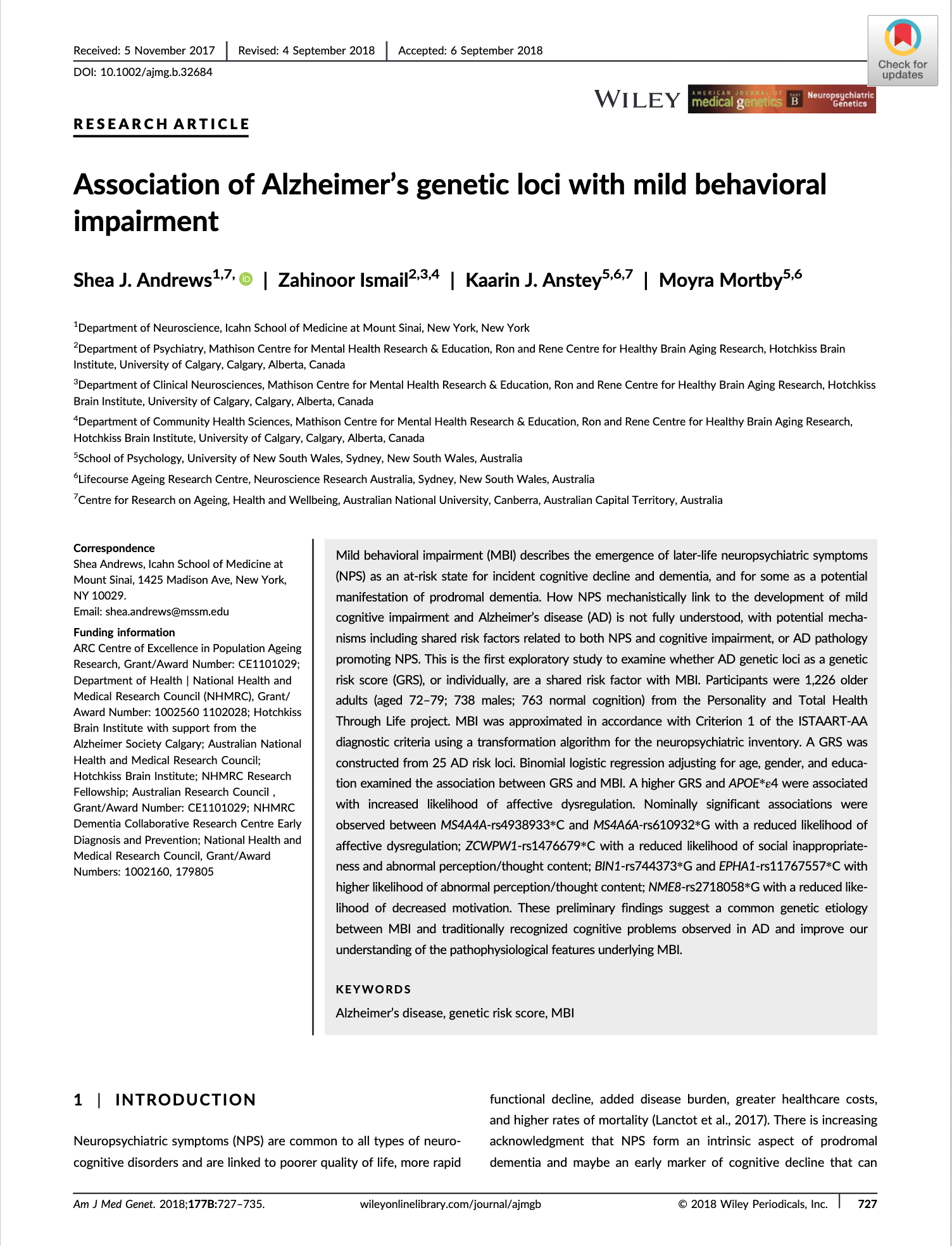 Association of Alzheimer’s genetic loci with mild behavioral impairmentShea J. Andrews, Zahinoor Ismail, Kaarin J. Anstey, and 1 more authorAmerican Journal of Medical Genetics Part B: Neuropsychiatric Genetics, 2018
Association of Alzheimer’s genetic loci with mild behavioral impairmentShea J. Andrews, Zahinoor Ismail, Kaarin J. Anstey, and 1 more authorAmerican Journal of Medical Genetics Part B: Neuropsychiatric Genetics, 2018Mild behavioral impairment (MBI) describes the emergence of later‐life neuropsychiatric symptoms (NPS) as an at‐risk state for incident cognitive decline and dementia, and for some as a potential manifestation of prodromal dementia. How NPS mechanistically link to the development of mild cognitive impairment and Alzheimer’s disease (AD) is not fully understood, with potential mechanisms including shared risk factors related to both NPS and cognitive impairment, or AD pathology promoting NPS. This is the first exploratory study to examine whether AD genetic loci as a genetic risk score (GRS), or individually, are a shared risk factor with MBI. Participants were 1,226 older adults (aged 72–79; 738 males; 763 normal cognition) from the Personality and Total Health Through Life project. MBI was approximated in accordance with Criterion 1 of the ISTAART‐AA diagnostic criteria using a transformation algorithm for the neuropsychiatric inventory. A GRS was constructed from 25 AD risk loci. Binomial logistic regression adjusting for age, gender, and education examined the association between GRS and MBI. A higher GRS and APOE*ε4 were associated with increased likelihood of affective dysregulation. Nominally significant associations were observed between MS4A4A‐rs4938933*C and MS4A6A‐rs610932*G with a reduced likelihood of affective dysregulation; ZCWPW1‐rs1476679*C with a reduced likelihood of social inappropriateness and abnormal perception/thought content; BIN1‐rs744373*G and EPHA1‐rs11767557*C with higher likelihood of abnormal perception/thought content; NME8‐rs2718058*G with a reduced likelihood of decreased motivation. These preliminary findings suggest a common genetic etiology between MBI and traditionally recognized cognitive problems observed in AD and improve our understanding of the pathophysiological features underlying MBI.
-
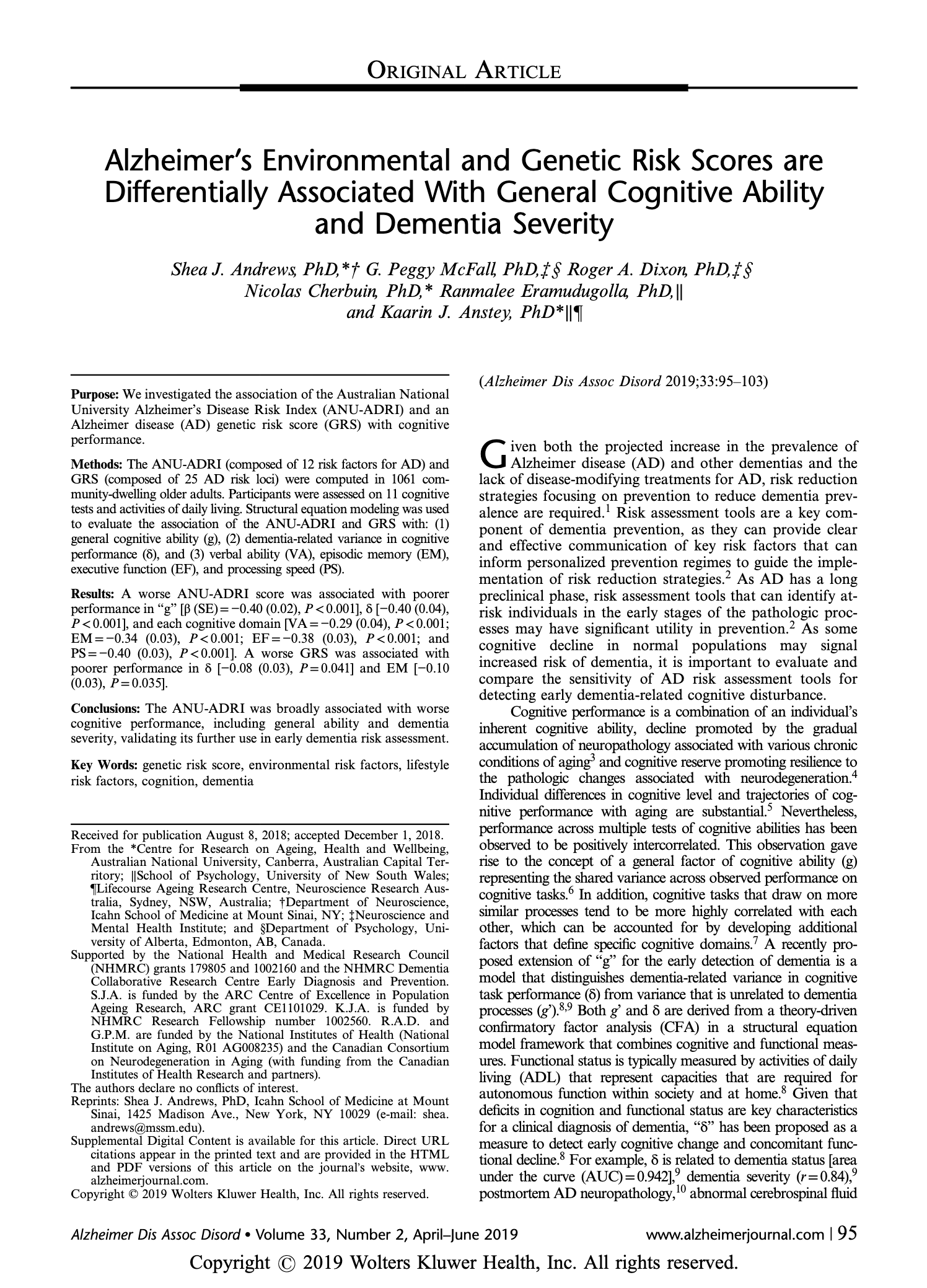 Alzheimer’s Environmental and Genetic Risk Scores are Differentially Associated With General Cognitive Ability and Dementia SeverityShea J. Andrews, G. Peggy McFall, Roger A. Dixon, and 3 more authorsAlzheimer Disease & Associated Disorders, 2018
Alzheimer’s Environmental and Genetic Risk Scores are Differentially Associated With General Cognitive Ability and Dementia SeverityShea J. Andrews, G. Peggy McFall, Roger A. Dixon, and 3 more authorsAlzheimer Disease & Associated Disorders, 2018We investigated the association of the Australian National University Alzheimer’s Disease Risk Index (ANU-ADRI) and an Alzheimer disease (AD) genetic risk score (GRS) with cognitive performance. The ANU-ADRI (composed of 12 risk factors for AD) and GRS (composed of 25 AD risk loci) were computed in 1061 community-dwelling older adults. Participants were assessed on 11 cognitive tests and activities of daily living. Structural equation modeling was used to evaluate the association of the ANU-ADRI and GRS with: (1) general cognitive ability (g), (2) dementia-related variance in cognitive performance (δ), and (3) verbal ability (VA), episodic memory (EM), executive function (EF), and processing speed (PS). A worse ANU-ADRI score was associated with poorer performance in “g” [β (SE)=−0.40 (0.02), P<0.001], δ [−0.40 (0.04), P<0.001], and each cognitive domain [VA=−0.29 (0.04), P<0.001; EM=−0.34 (0.03), P<0.001; EF=−0.38 (0.03), P<0.001; and PS=−0.40 (0.03), P<0.001]. A worse GRS was associated with poorer performance in δ [−0.08 (0.03), P=0.041] and EM [−0.10 (0.03), P=0.035]. The ANU-ADRI was broadly associated with worse cognitive performance, including general ability and dementia severity, validating its further use in early dementia risk assessment.
2017
-
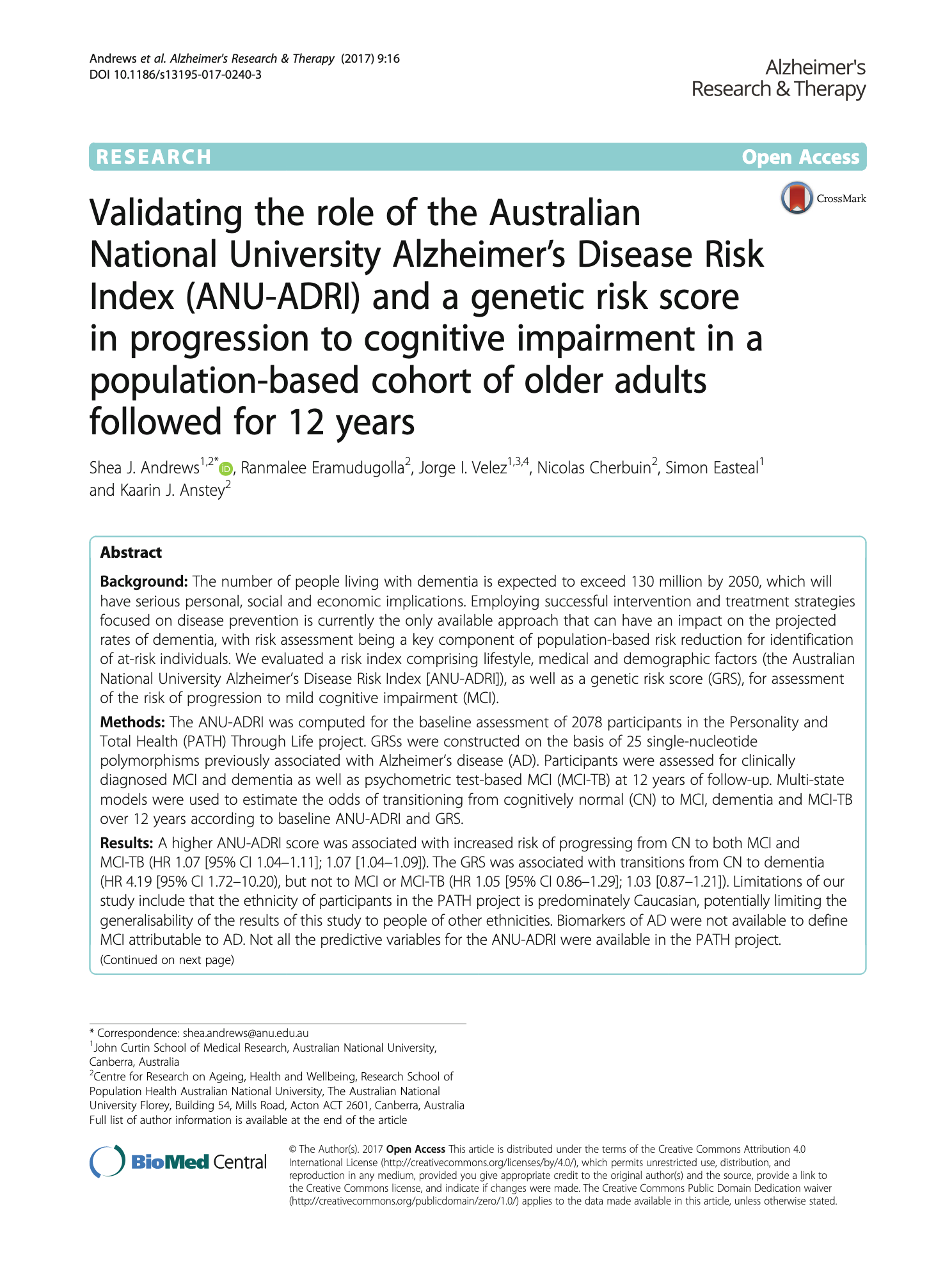 Validating the role of the Australian National University Alzheimer’s Disease Risk Index (ANU-ADRI) and a genetic risk score in progression to cognitive impairment in a population-based cohort of older adults followed for 12 yearsShea J. Andrews, Ranmalee Eramudugolla, Jorge I. Velez, and 3 more authorsAlzheimer’s Research & Therapy, 2017
Validating the role of the Australian National University Alzheimer’s Disease Risk Index (ANU-ADRI) and a genetic risk score in progression to cognitive impairment in a population-based cohort of older adults followed for 12 yearsShea J. Andrews, Ranmalee Eramudugolla, Jorge I. Velez, and 3 more authorsAlzheimer’s Research & Therapy, 2017The number of people living with dementia is expected to exceed 130 million by 2050, which will have serious personal, social and economic implications. Employing successful intervention and treatment strategies focused on disease prevention is currently the only available approach that can have an impact on the projected rates of dementia, with risk assessment being a key component of population-based risk reduction for identification of at-risk individuals. We evaluated a risk index comprising lifestyle, medical and demographic factors (the Australian National University Alzheimer’s Disease Risk Index [ANU-ADRI]), as well as a genetic risk score (GRS), for assessment of the risk of progression to mild cognitive impairment (MCI). The ANU-ADRI was computed for the baseline assessment of 2078 participants in the Personality and Total Health (PATH) Through Life project. GRSs were constructed on the basis of 25 single-nucleotide polymorphisms previously associated with Alzheimer’s disease (AD). Participants were assessed for clinically diagnosed MCI and dementia as well as psychometric test-based MCI (MCI-TB) at 12 years of follow-up. Multi-state models were used to estimate the odds of transitioning from cognitively normal (CN) to MCI, dementia and MCI-TB over 12 years according to baseline ANU-ADRI and GRS. A higher ANU-ADRI score was associated with increased risk of progressing from CN to both MCI and MCI-TB (HR 1.07 [95% CI 1.04–1.11]; 1.07 [1.04–1.09]). The GRS was associated with transitions from CN to dementia (HR 4.19 [95% CI 1.72–10.20), but not to MCI or MCI-TB (HR 1.05 [95% CI 0.86–1.29]; 1.03 [0.87–1.21]). Limitations of our study include that the ethnicity of participants in the PATH project is predominately Caucasian, potentially limiting the generalisability of the results of this study to people of other ethnicities. Biomarkers of AD were not available to define MCI attributable to AD. Not all the predictive variables for the ANU-ADRI were available in the PATH project. In the general population, the ANU-ADRI, comprising lifestyle, medical and demographic factors, is associated with the risk of progression from CN to MCI, whereas a GRS comprising the main AD risk genes was not associated with this risk. The ANU-ADRI may be used for population-level risk assessment and screening.
-
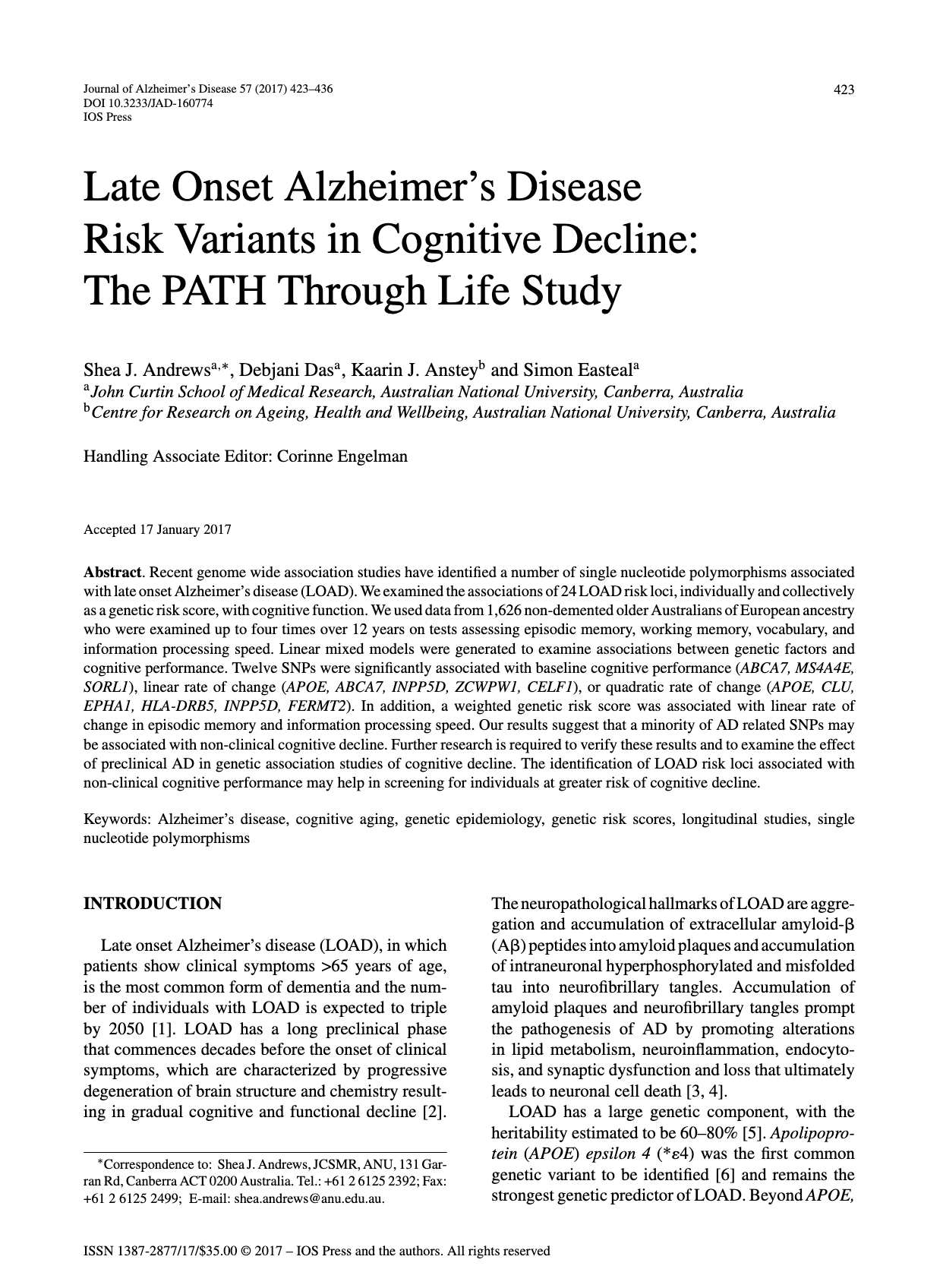 Late Onset Alzheimer’s Disease Risk Variants in Cognitive Decline: The PATH Through Life StudyShea J. Andrews, Debjani Das, Kaarin J. Anstey, and 1 more authorJournal of Alzheimer’s Disease, 2017
Late Onset Alzheimer’s Disease Risk Variants in Cognitive Decline: The PATH Through Life StudyShea J. Andrews, Debjani Das, Kaarin J. Anstey, and 1 more authorJournal of Alzheimer’s Disease, 2017Recent genome wide association studies have identified a number of single nucleotide polymorphisms associated with late onset Alzheimer’s disease (LOAD). We examined the associations of 24 LOAD risk loci, individually and collectively as a genetic risk score, with cognitive function. We used data from 1,626 non-demented older Australians of European ancestry who were examined up to four times over 12 years on tests assessing episodic memory, working memory, vocabulary, and information processing speed. Linear mixed models were generated to examine associations between genetic factors and cognitive performance. Twelve SNPs were significantly associated with baseline cognitive performance (ABCA7, MS4A4E, SORL1), linear rate of change (APOE, ABCA7, INPP5D, ZCWPW1, CELF1), or quadratic rate of change (APOE, CLU, EPHA1, HLA-DRB5, INPP5D, FERMT2). In addition, a weighted genetic risk score was associated with linear rate of change in episodic memory and information processing speed. Our results suggest that a minority of AD related SNPs may be associated with non-clinical cognitive decline. Further research is required to verify these results and to examine the effect of preclinical AD in genetic association studies of cognitive decline. The identification of LOAD risk loci associated with non-clinical cognitive performance may help in screening for individuals at greater risk of cognitive decline.
-
 Association of AKAP6 and MIR2113 with cognitive performance in a population‐based sample of older adultsS. J. Andrews, D. Das, K. J. Anstey, and 1 more authorGenes, Brain and Behavior, 2017
Association of AKAP6 and MIR2113 with cognitive performance in a population‐based sample of older adultsS. J. Andrews, D. Das, K. J. Anstey, and 1 more authorGenes, Brain and Behavior, 2017Genetic factors make a substantial contribution to inter-individual variability in cognitive function. A recent meta-analysis of genome-wide association studies identified two loci, AKAP6 and MIR2113, that are associated with general cognitive function. Here, we extend this previous research by investigating the association of MIR2113 and AKAP6 with baseline and longitudinal non-linear change across a broad spectrum of cognitive domains in a community-based cohort of older adults without dementia. Two single nucleotide polymorphisms (SNPs), MIR211-rs10457441 and AKAP6-rs17522122 were genotyped in 1570 non-demented older Australians of European ancestry, who were examined up to 4 times over 12 years. Linear mixed effects models were used to examine the association between AKAP6 and MIR2113 with cognitive performance in episodic memory, working memory, vocabulary, perceptual speed and reaction time at baseline and with linear and quadratic rates of change. AKAP6-rs17522122*T was associated with worse baseline performance in episodic memory, working memory, vocabulary and perceptual speed, but it was not associated with cognitive change in any domain. MIR2113-rs10457441*T was associated with accelerated decline in episodic memory. No other associations with baseline cognitive performance or with linear or quadratic rate or cognitive changes were observed for this SNP. These results confirm the previous finding that AKAP6 is associated with performance across multiple cognitive domains at baseline but not with cognitive decline, while MIR2113 primarily affects the rate at which memory declines over time.
2016
-
 Memory Resilience to Alzheimer’s Genetic Risk: Sex Effects in Predictor ProfilesKirstie L McDermott, G Peggy McFall, Shea J Andrews, and 2 more authorsThe Journals of Gerontology Series B: Psychological Sciences and Social Sciences, 2016
Memory Resilience to Alzheimer’s Genetic Risk: Sex Effects in Predictor ProfilesKirstie L McDermott, G Peggy McFall, Shea J Andrews, and 2 more authorsThe Journals of Gerontology Series B: Psychological Sciences and Social Sciences, 2016Apolipoprotein E (APOE) ɛ4 and Clusterin (CLU) C alleles are risk factors for Alzheimer’s disease (AD) and episodic memory (EM) decline. Memory resilience occurs when genetically at-risk adults perform at high and sustained levels. We investigated whether (a) memory resilience to AD genetic risk is predicted by biological and other risk markers and (b) the prediction profiles vary by sex and AD risk variant.
-
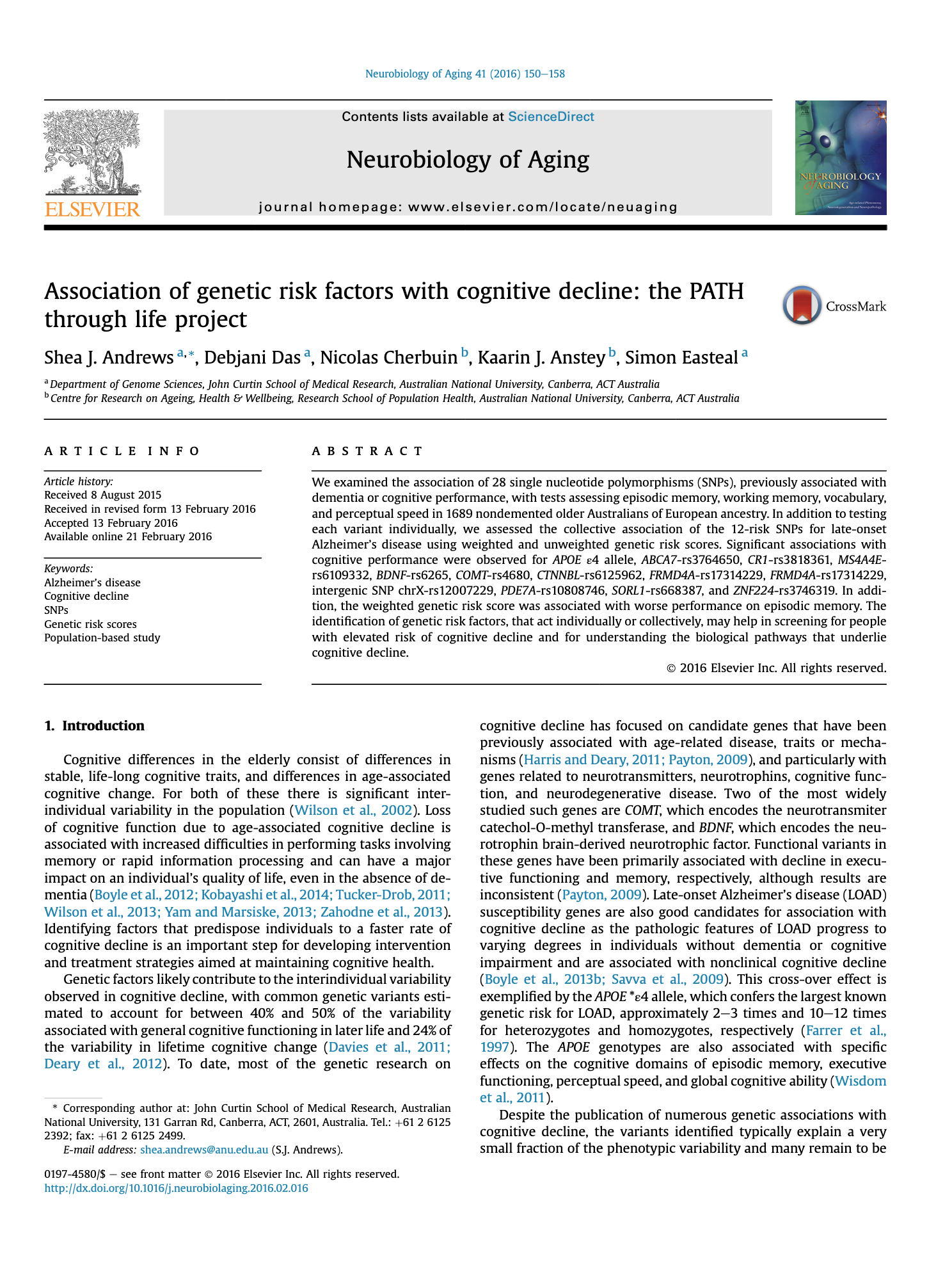 Association of genetic risk factors with cognitive decline: the PATH through life projectShea J. Andrews, Debjani Das, Nicolas Cherbuin, and 2 more authorsNeurobiology of Aging, 2016
Association of genetic risk factors with cognitive decline: the PATH through life projectShea J. Andrews, Debjani Das, Nicolas Cherbuin, and 2 more authorsNeurobiology of Aging, 2016We examined the association of 28 single nucleotide polymorphisms (SNPs), previously associated with dementia or cognitive performance, with tests assessing episodic memory, working memory, vocabulary, and perceptual speed in 1689 nondemented older Australians of European ancestry. In addition to testing each variant individually, we assessed the collective association of the 12-risk SNPs for late-onset Alzheimer’s disease using weighted and unweighted genetic risk scores. Significant associations with cognitive performance were observed for APOE ε4 allele, ABCA7-rs3764650, CR1-rs3818361, MS4A4E-rs6109332, BDNF-rs6265, COMT-rs4680, CTNNBL-rs6125962, FRMD4A-rs17314229, FRMD4A-rs17314229, intergenic SNP chrX-rs12007229, PDE7A-rs10808746, SORL1-rs668387, and ZNF224-rs3746319. In addition, the weighted genetic risk score was associated with worse performance on episodic memory. The identification of genetic risk factors, that act individually or collectively, may help in screening for people with elevated risk of cognitive decline and for understanding the biological pathways that underlie cognitive decline.
-
 APOE*E2 allele delays age of onset in PSEN1 E280A Alzheimer’s diseaseJ I Vélez, F Lopera, D Sepulveda-Falla, and 19 more authorsMolecular Psychiatry, 2016
APOE*E2 allele delays age of onset in PSEN1 E280A Alzheimer’s diseaseJ I Vélez, F Lopera, D Sepulveda-Falla, and 19 more authorsMolecular Psychiatry, 2016Alzheimer’s disease (AD) age of onset (ADAOO) varies greatly between individuals, with unique causal mutations suggesting the role of modifying genetic and environmental interactions. We analyzed \textbackslashtextasciitilde50 000 common and rare functional genomic variants from 71 individuals of the ‘Paisa’ pedigree, the world’s largest pedigree segregating a severe form of early-onset AD, who were affected carriers of the fully penetrant E280A mutation in the presenilin-1 (PSEN1) gene. Affected carriers with ages at the extremes of the ADAOO distribution (30s–70s age range), and linear mixed-effects models were used to build single-locus regression models outlining the ADAOO. We identified the rs7412 (APOE*E2 allele) as a whole exome-wide ADAOO modifier that delays ADAOO by \textbackslashtextasciitilde12 years (β=11.74, 95% confidence interval (CI): 8.07–15.41, P=6.31 × 10−8, PFDR=2.48 × 10−3). Subsequently, to evaluate comprehensively the APOE (apolipoprotein E) haplotype variants (E1/E2/E3/E4), the markers rs7412 and rs429358 were genotyped in 93 AD affected carriers of the E280A mutation. We found that the APOE*E2 allele, and not APOE*E4, modifies ADAOO in carriers of the E280A mutation (β=8.24, 95% CI: 4.45–12.01, P=3.84 × 10−5). Exploratory linear mixed-effects multilocus analysis suggested that other functional variants harbored in genes involved in cell proliferation, protein degradation, apoptotic and immune dysregulation processes (i.e., GPR20, TRIM22, FCRL5, AOAH, PINLYP, IFI16, RC3H1 and DFNA5) might interact with the APOE*E2 allele. Interestingly, suggestive evidence as an ADAOO modifier was found for one of these variants (GPR20) in a set of patients with sporadic AD from the Paisa genetic isolate. This is the first study demonstrating that the APOE*E2 allele modifies the natural history of AD typified by the age of onset in E280A mutation carriers. To the best of our knowledge, this is the largest analyzed sample of patients with a unique mutation sharing uniform environment. Formal replication of our results in other populations and in other forms of AD will be crucial for prediction, follow-up and presumably developing new therapeutic strategies for patients either at risk or affected by AD.
2015
-
 Interactive Effect of APOE Genotype and Blood Pressure on Cognitive Decline: The PATH Through Life StudyShea Andrews, Debjani Das, Kaarin J. Anstey, and 1 more authorJournal of Alzheimer’s Disease, 2015
Interactive Effect of APOE Genotype and Blood Pressure on Cognitive Decline: The PATH Through Life StudyShea Andrews, Debjani Das, Kaarin J. Anstey, and 1 more authorJournal of Alzheimer’s Disease, 2015The apolipoprotein E (APOE) *ε4 allele and hypertension are two of the most prevalent risk factors for cognitive decline in later life. Here we investigate whether cognitive decline is affected by interaction between these two risk factors. Specifically, we examine whether APOE*ε4 moderates the association between high blood pressure and cognition in later life. Cognitive function was assessed at three time points over a period of 8 years in 1,474 cognitively normal, community-dwelling adults aged 60–64 years at baseline. Blood pressure and APOE genotype were assessed at baseline. Blood pressure was measured categorically as ‘Hypertension’ and continuously as ‘Mean Arterial Pressure’ (MAP). Multilevel models were used to investigate main and interactive effects of APOE genotype and both hypertension and MAP on the rate of change of episodic memory, working memory, verbal ability, perceptual speed, and global cognition. The APOE–hypertension interaction was associated with a small but statistically significant increase in the rate of decline of episodic memory, verbal ability, and global cognition. However, its inclusion in the model did not increase the amount of outcome variation explained beyond that already explained by the effect of time. In contrast, the APOE-MAP interaction had no effect on the rate of decline in any of these domains of cognitive performance. These results provide tentative evidence that APOE genotype moderates the association between high blood pressure and cognitive decline in later life.
2014
-
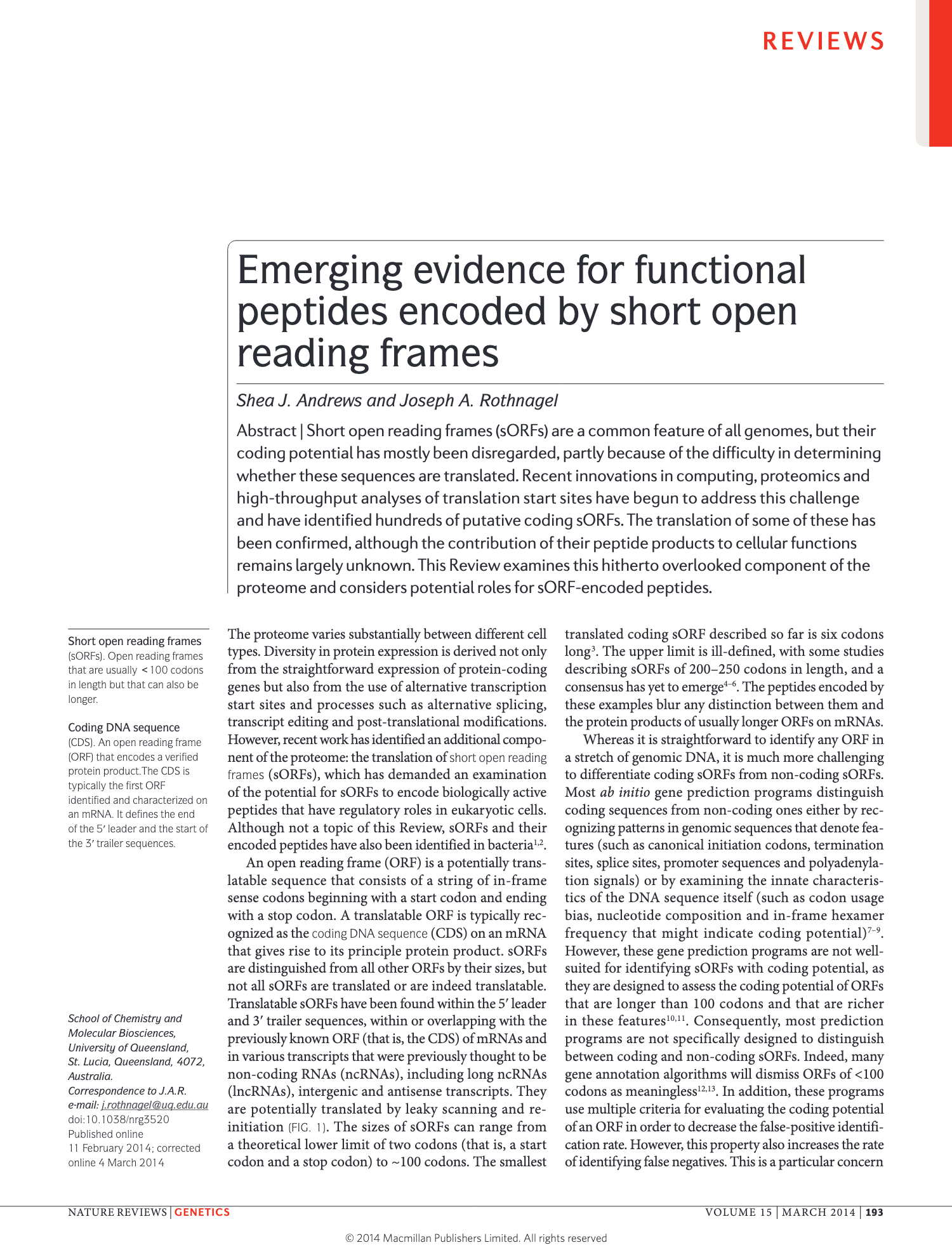 Emerging evidence for functional peptides encoded by short open reading framesShea J. Andrews, and Joseph A. RothnagelNature Reviews Genetics, 2014
Emerging evidence for functional peptides encoded by short open reading framesShea J. Andrews, and Joseph A. RothnagelNature Reviews Genetics, 2014Short open reading frames (sORFs) of ∼100 codons in length are common and are distributed throughout the genome, but not all sORFs are biologically relevant.sORFs are found on non-coding RNAs and within the 5′ leader and 3′ trailer regions of mRNAs. They can also overlap with the main protein-coding sequence of mRNAs.The identification of sORFs that are translatable and that are likely to encode short peptides remains a major challenge. Three complementary approaches that are typically used to discover functional sORFs are bioinformatics, transcriptomics and proteomics.Bioinformatic studies have identified a large pool of potentially translatable sORFs on the basis of sequence characteristics such as degree of conservation, coding potential and context of the initiation codon.Global ribosome profiling has provided evidence of ribosome engagement at the start codon of many sORFs in various species, including yeast, insects, plants and mammals.Proteomic studies using mass spectrometry on size-fractionated whole-cell lysates have identified several short peptides encoded by sORFs (sPEPs) in human tissues and cell lines.Functional sPEPs have been identified in insects, plants and mammals, but only a small number of them have been fully characterized. Short open reading frames (sORFs) of ∼100 codons in length are common and are distributed throughout the genome, but not all sORFs are biologically relevant. sORFs are found on non-coding RNAs and within the 5′ leader and 3′ trailer regions of mRNAs. They can also overlap with the main protein-coding sequence of mRNAs. The identification of sORFs that are translatable and that are likely to encode short peptides remains a major challenge. Three complementary approaches that are typically used to discover functional sORFs are bioinformatics, transcriptomics and proteomics. Bioinformatic studies have identified a large pool of potentially translatable sORFs on the basis of sequence characteristics such as degree of conservation, coding potential and context of the initiation codon. Global ribosome profiling has provided evidence of ribosome engagement at the start codon of many sORFs in various species, including yeast, insects, plants and mammals. Proteomic studies using mass spectrometry on size-fractionated whole-cell lysates have identified several short peptides encoded by sORFs (sPEPs) in human tissues and cell lines. Functional sPEPs have been identified in insects, plants and mammals, but only a small number of them have been fully characterized. Recent advances in bioinformatics, proteomics and high-throughput analyses of translation have begun to uncover short open reading frames (sORFs) with coding potential. This Review considers unifying characteristics of these sORFs, methods to identify them and potential functions of the resultant short peptides. Short open reading frames (sORFs) are a common feature of all genomes, but their coding potential has mostly been disregarded, partly because of the difficulty in determining whether these sequences are translated. Recent innovations in computing, proteomics and high-throughput analyses of translation start sites have begun to address this challenge and have identified hundreds of putative coding sORFs. The translation of some of these has been confirmed, although the contribution of their peptide products to cellular functions remains largely unknown. This Review examines this hitherto overlooked component of the proteome and considers potential roles for sORF-encoded peptides.